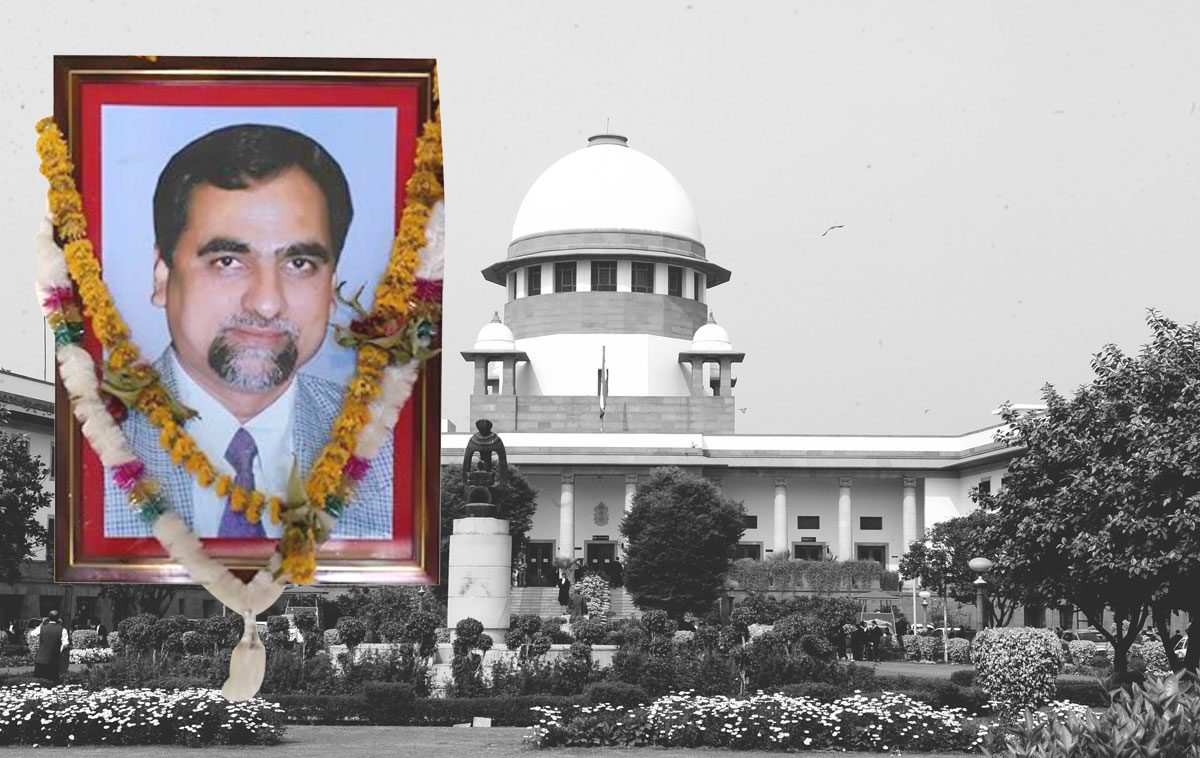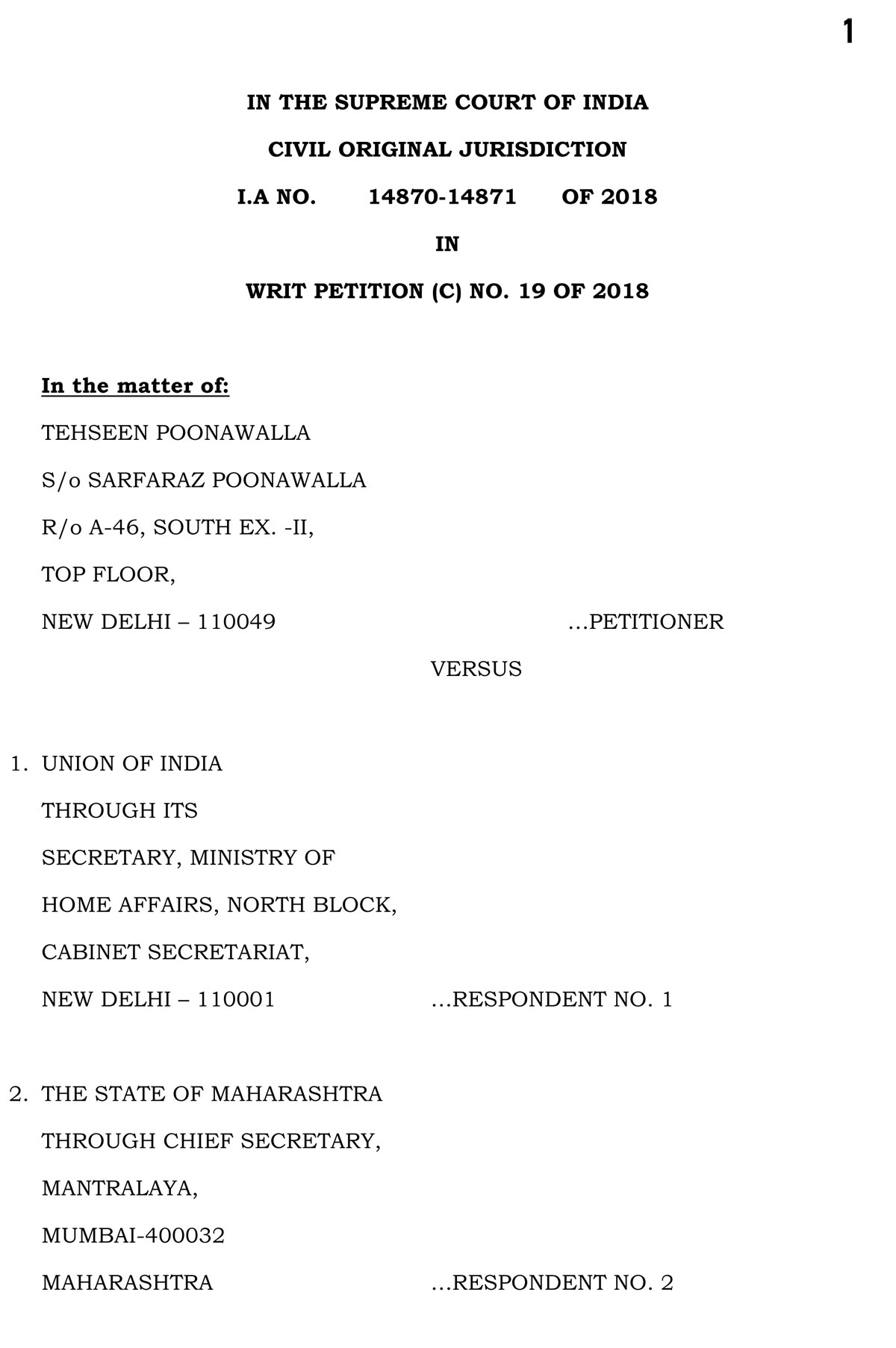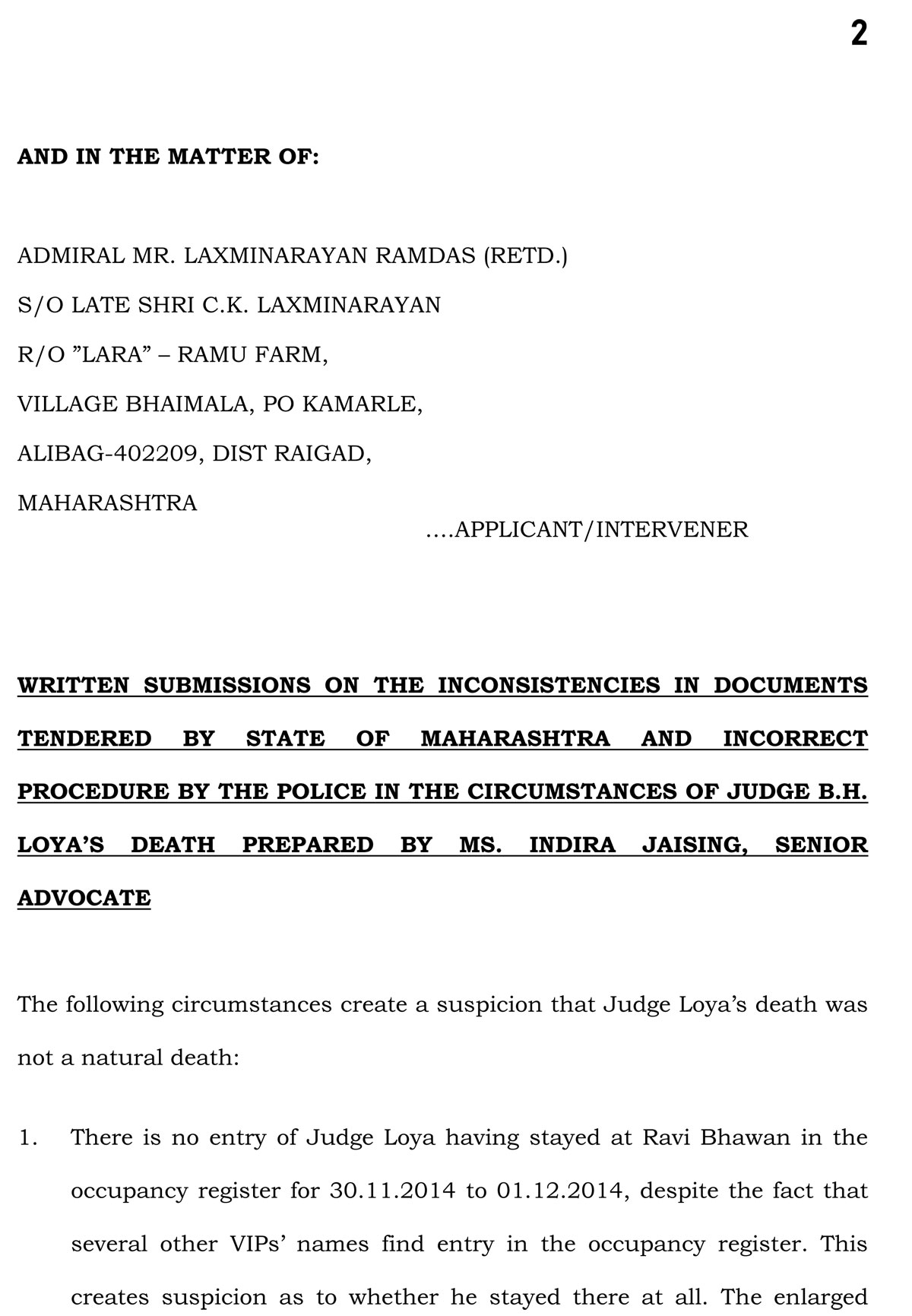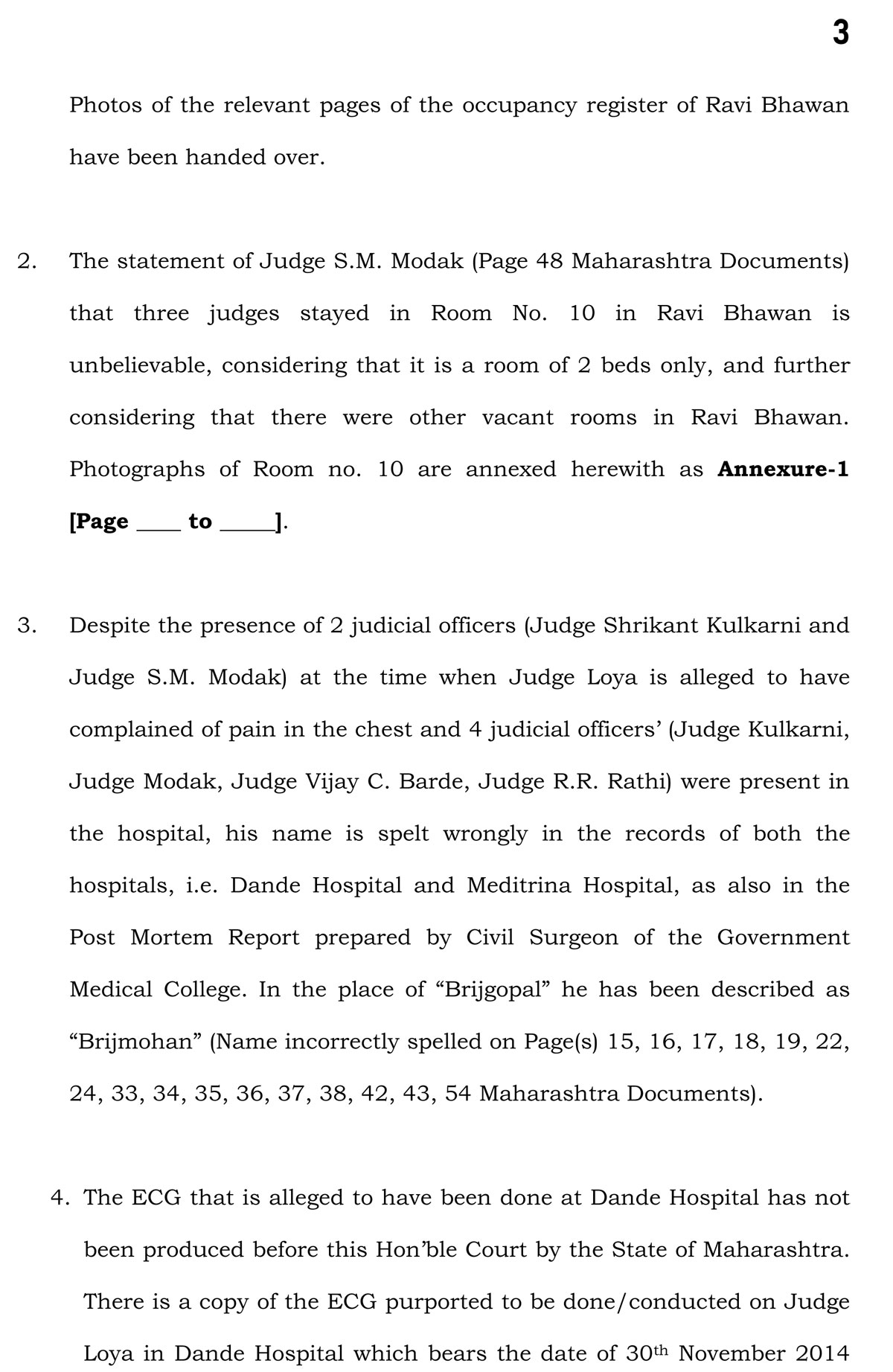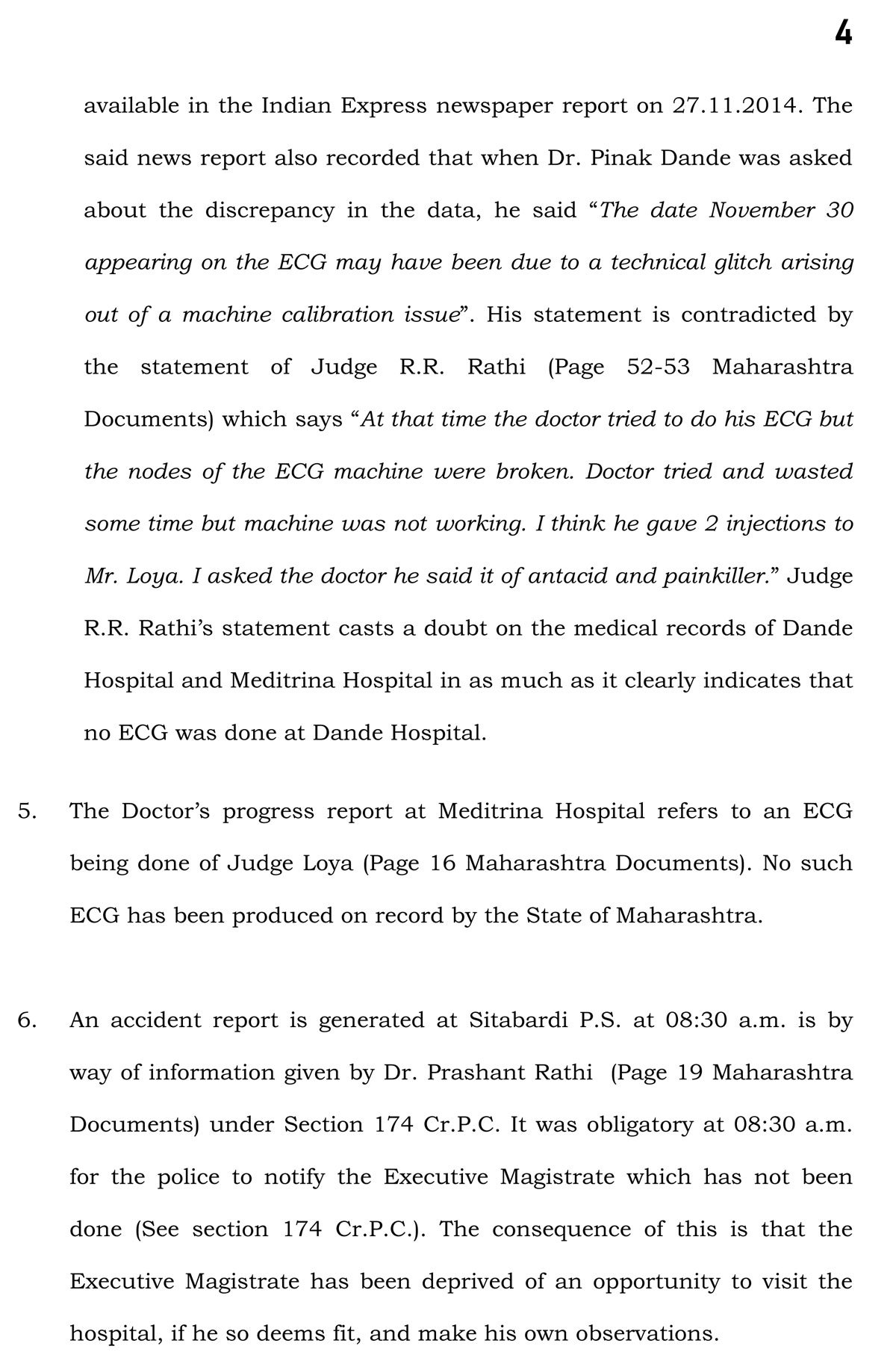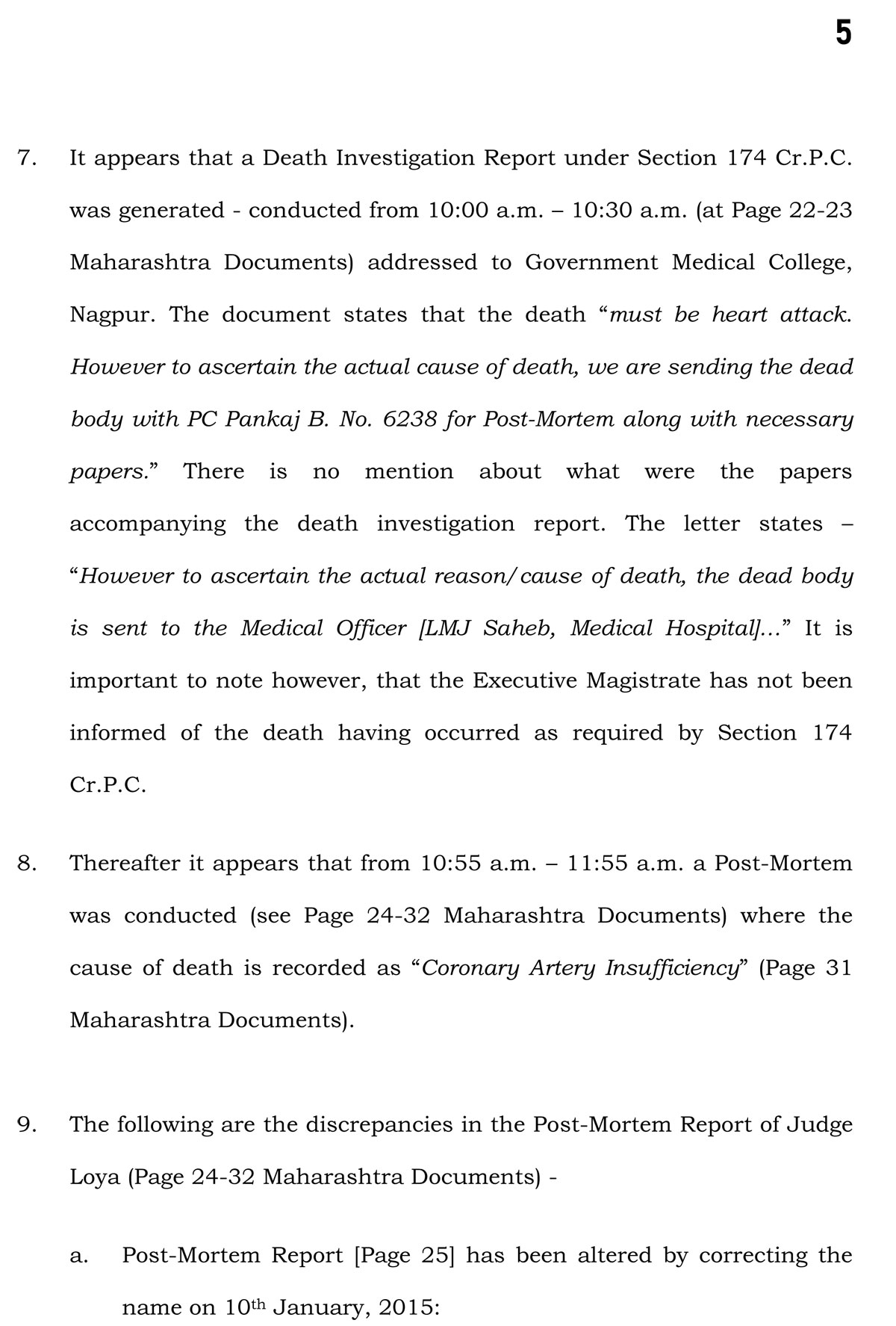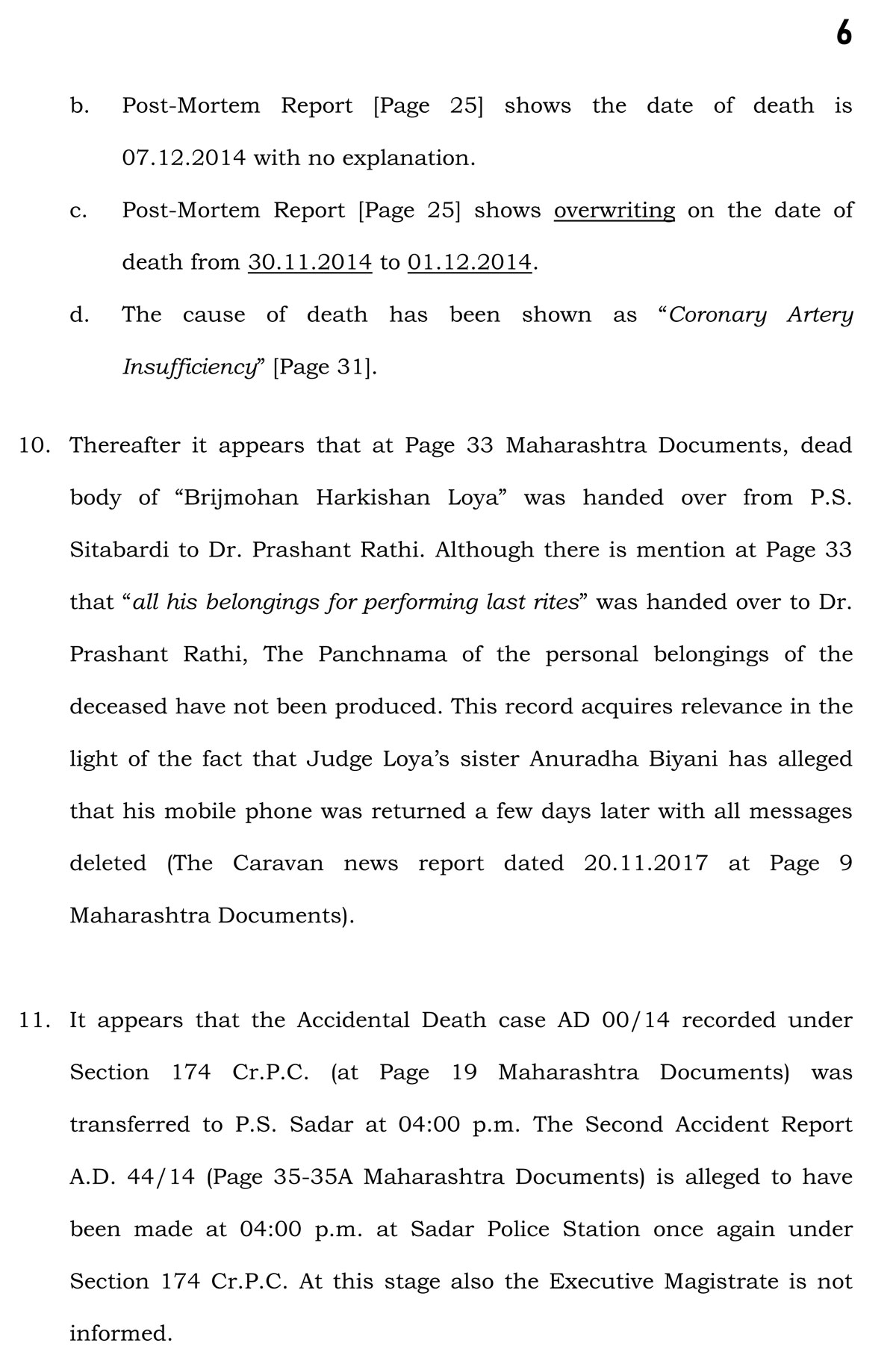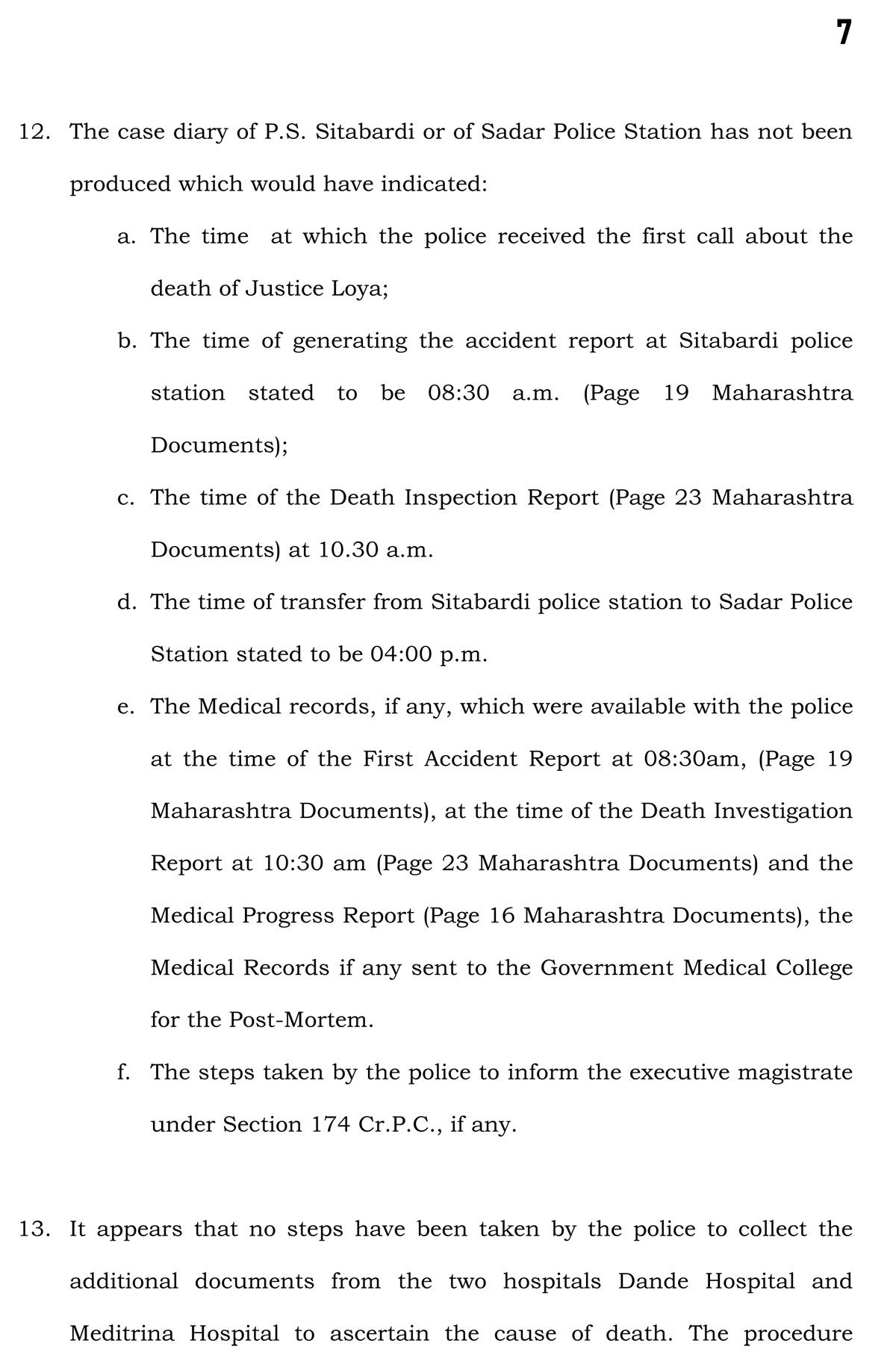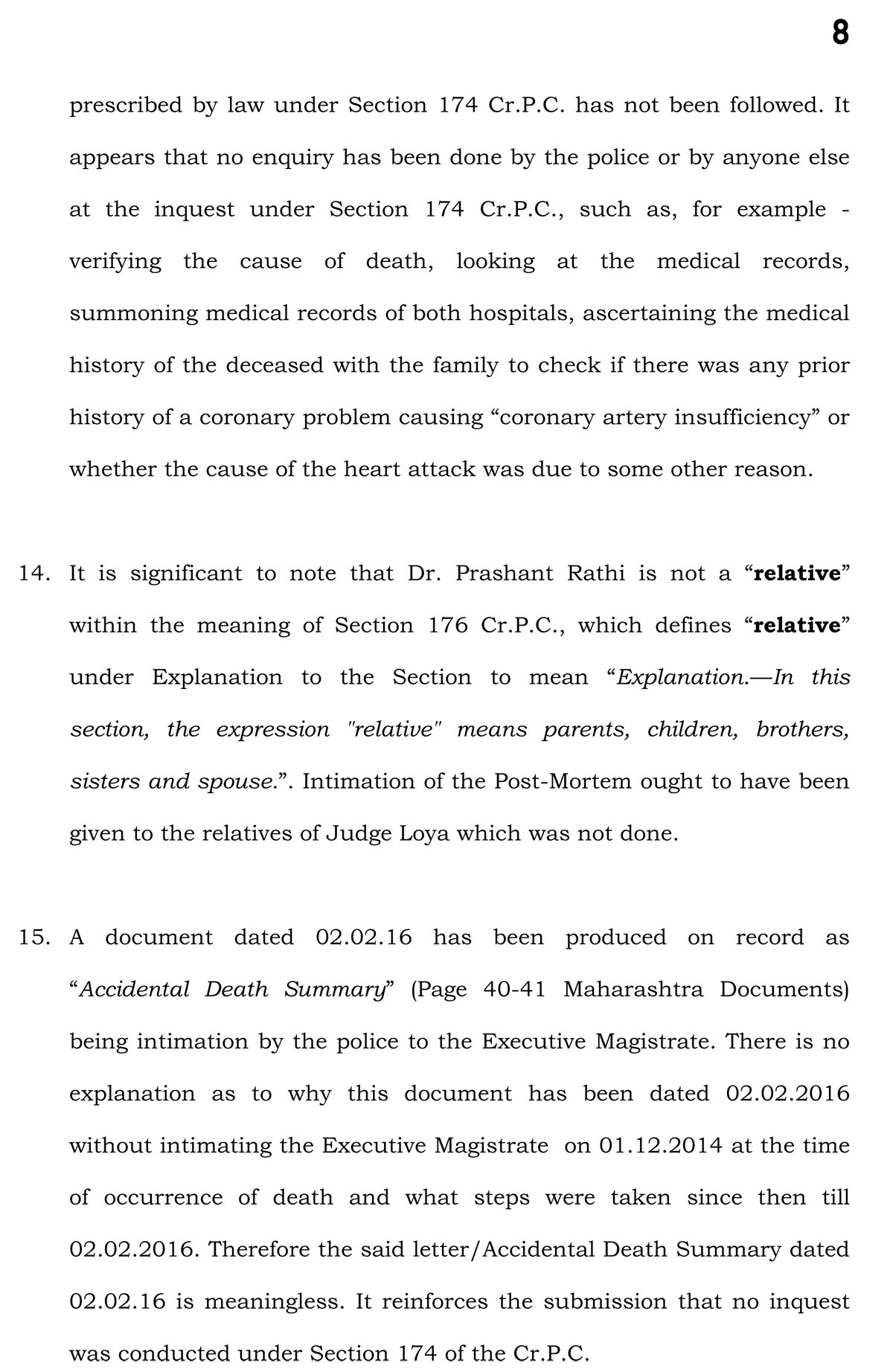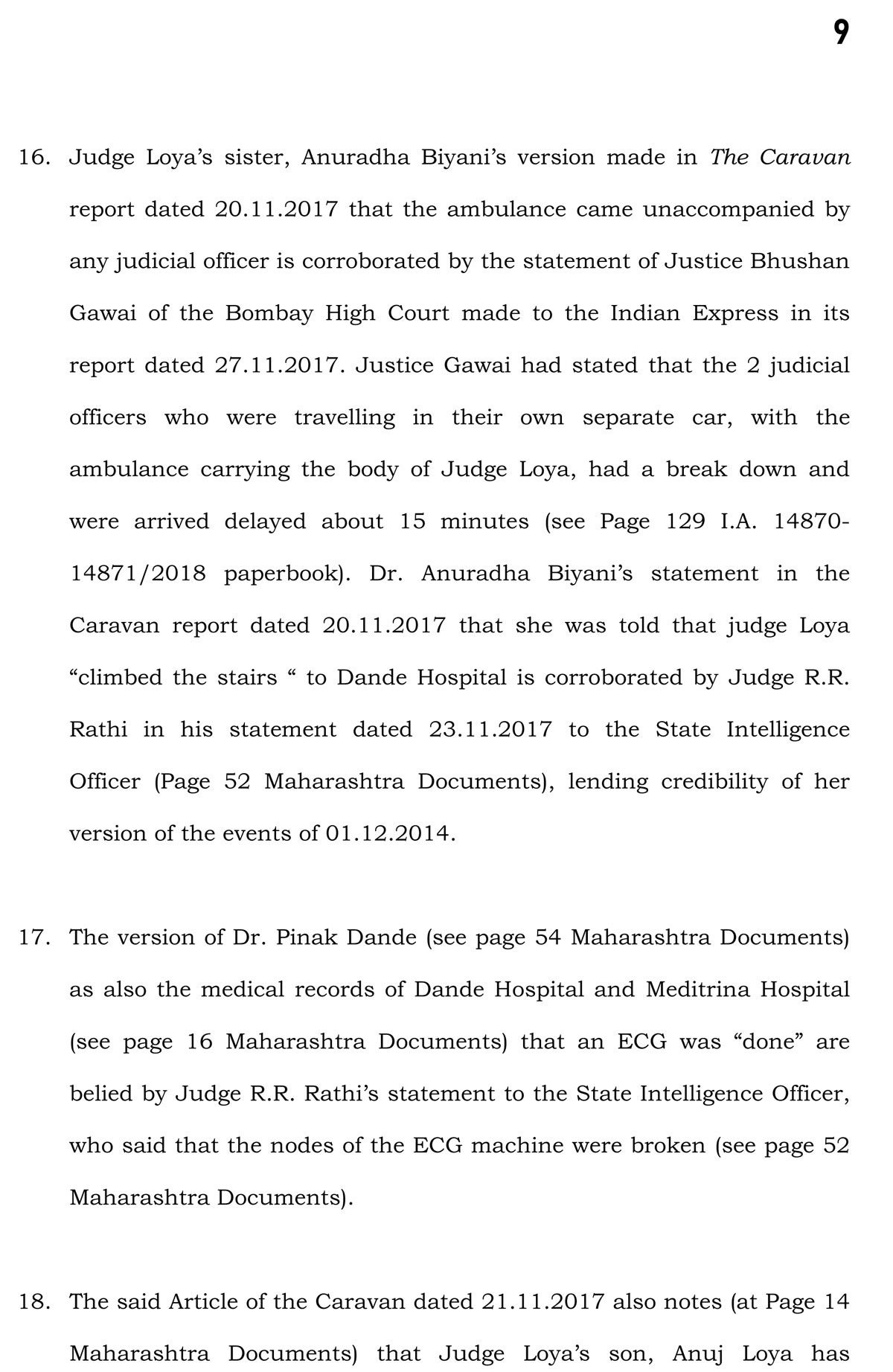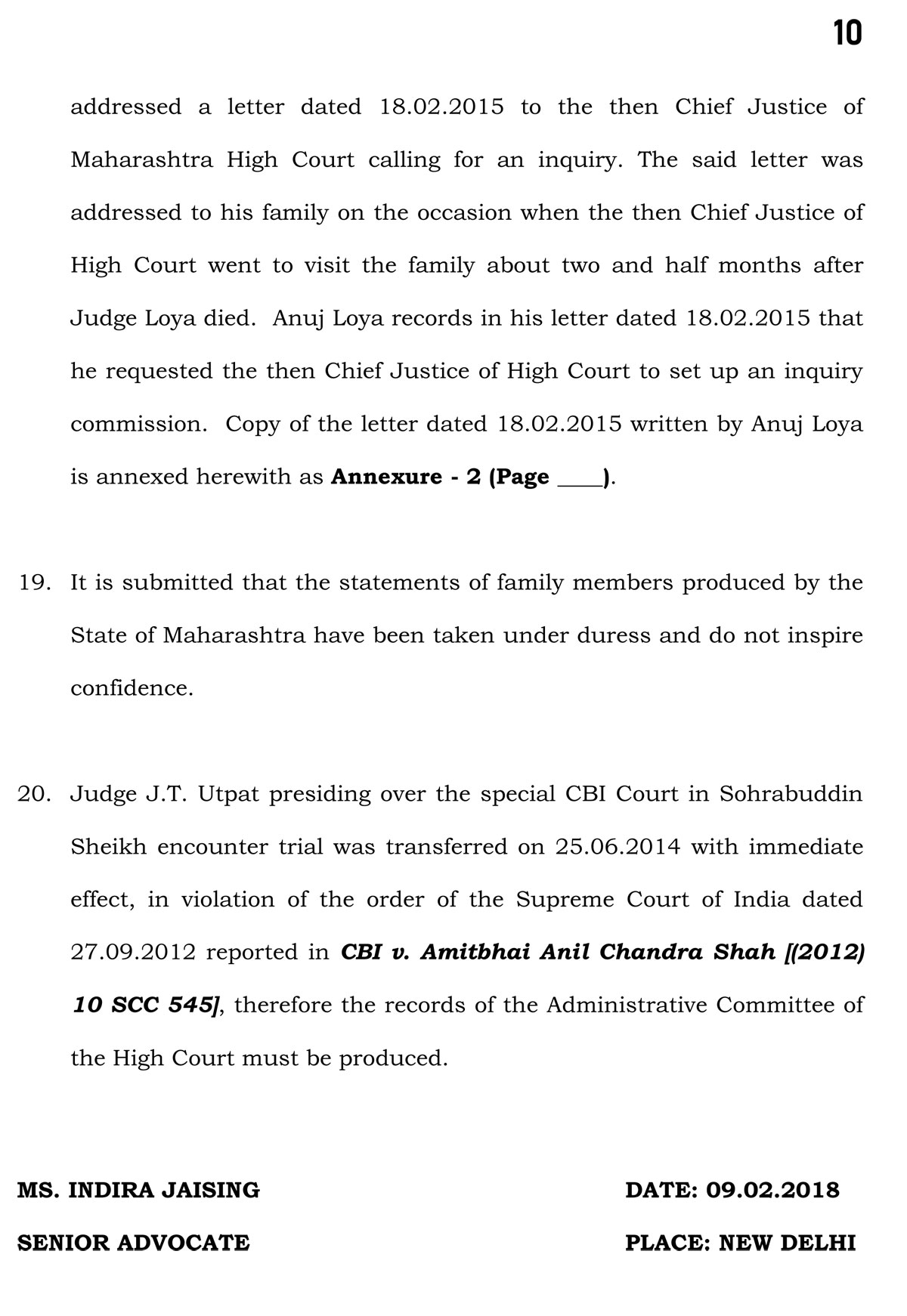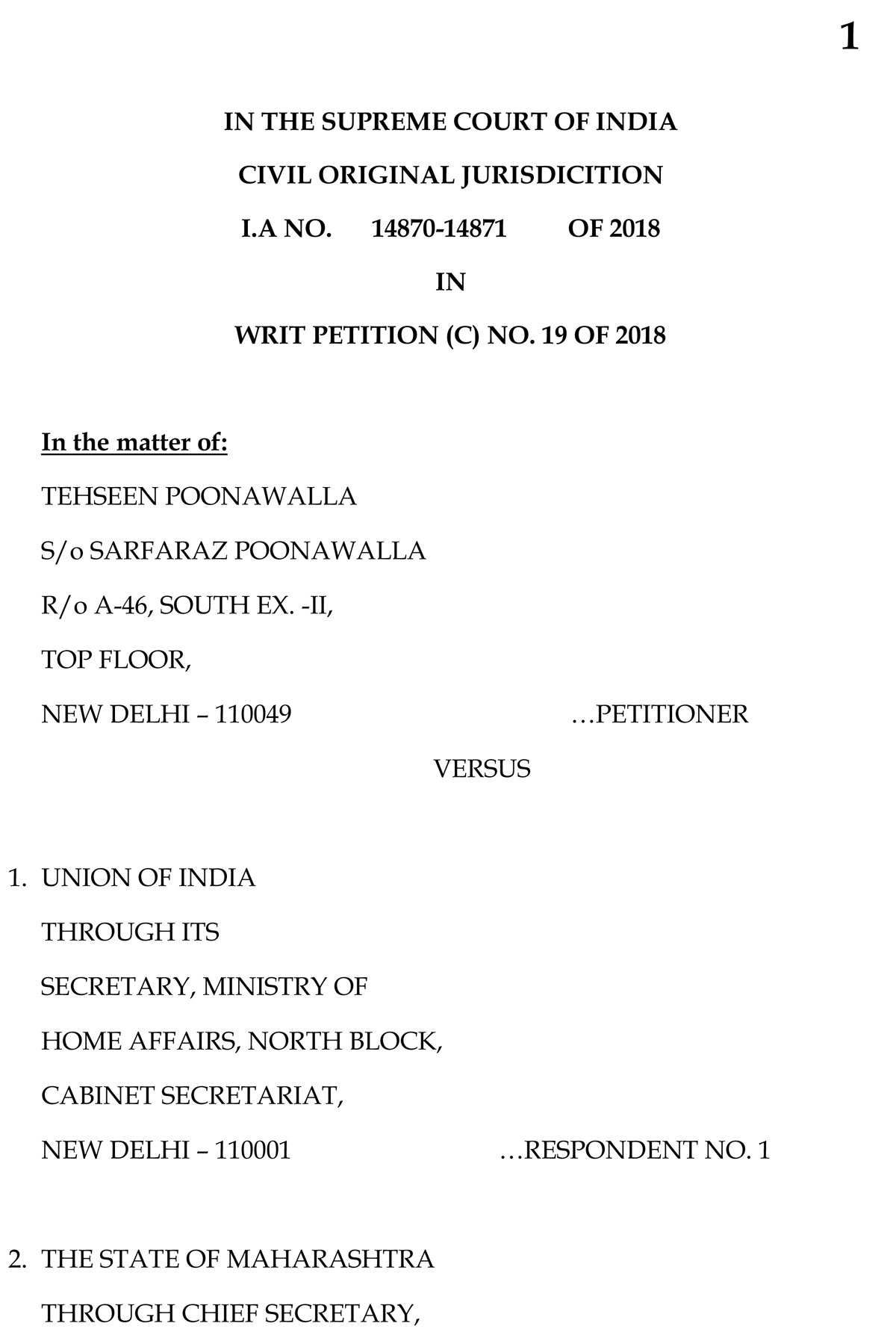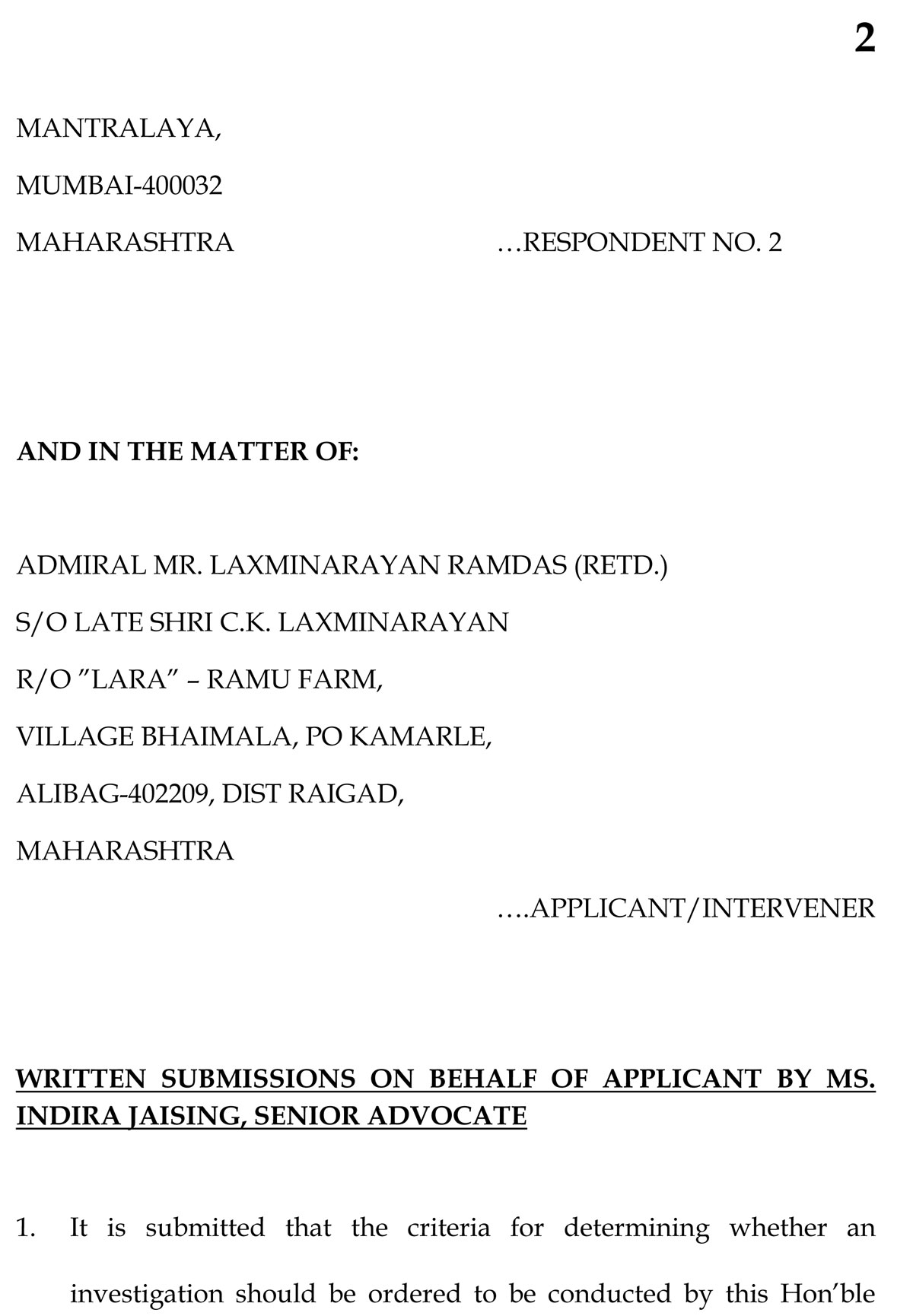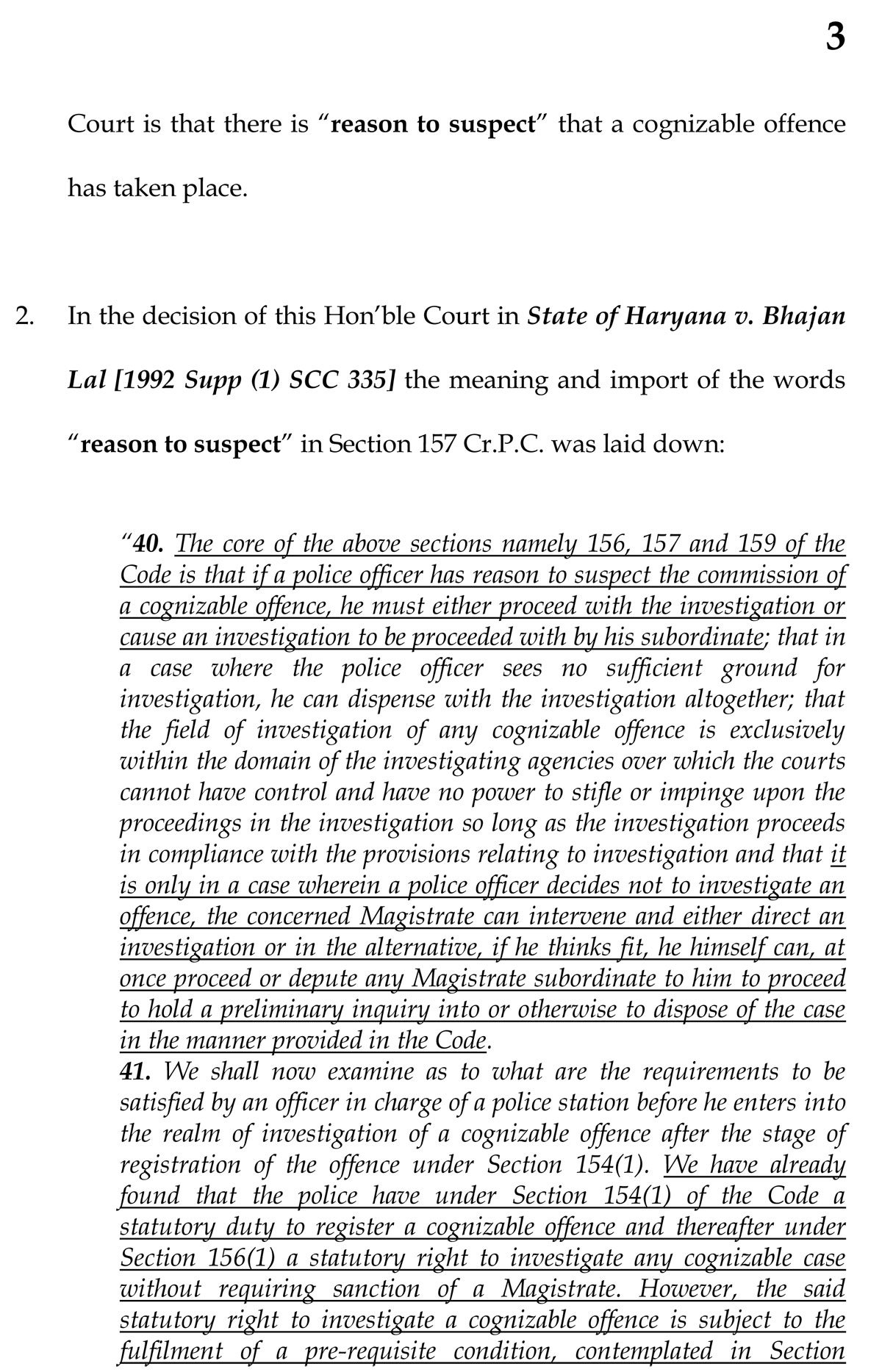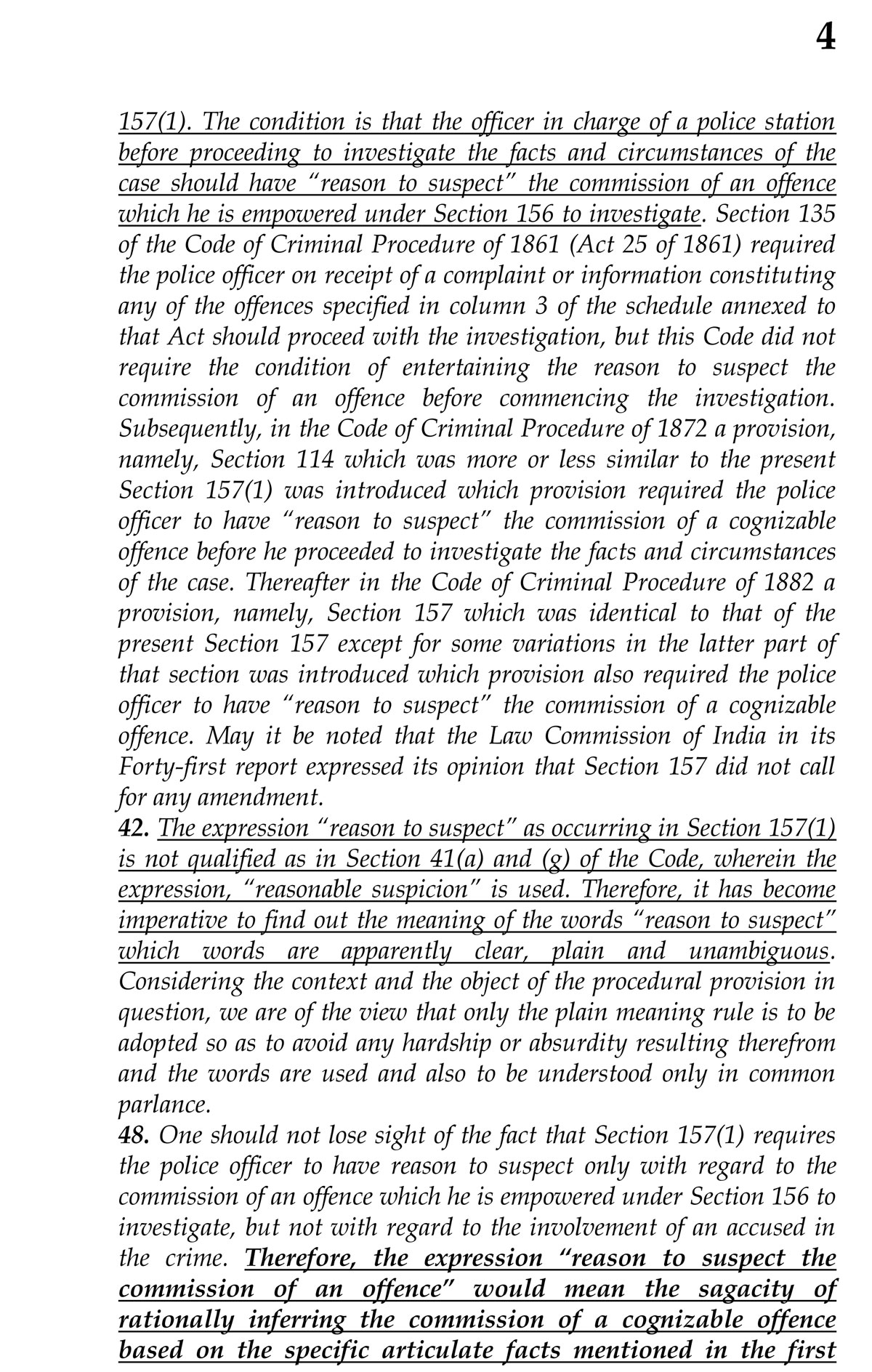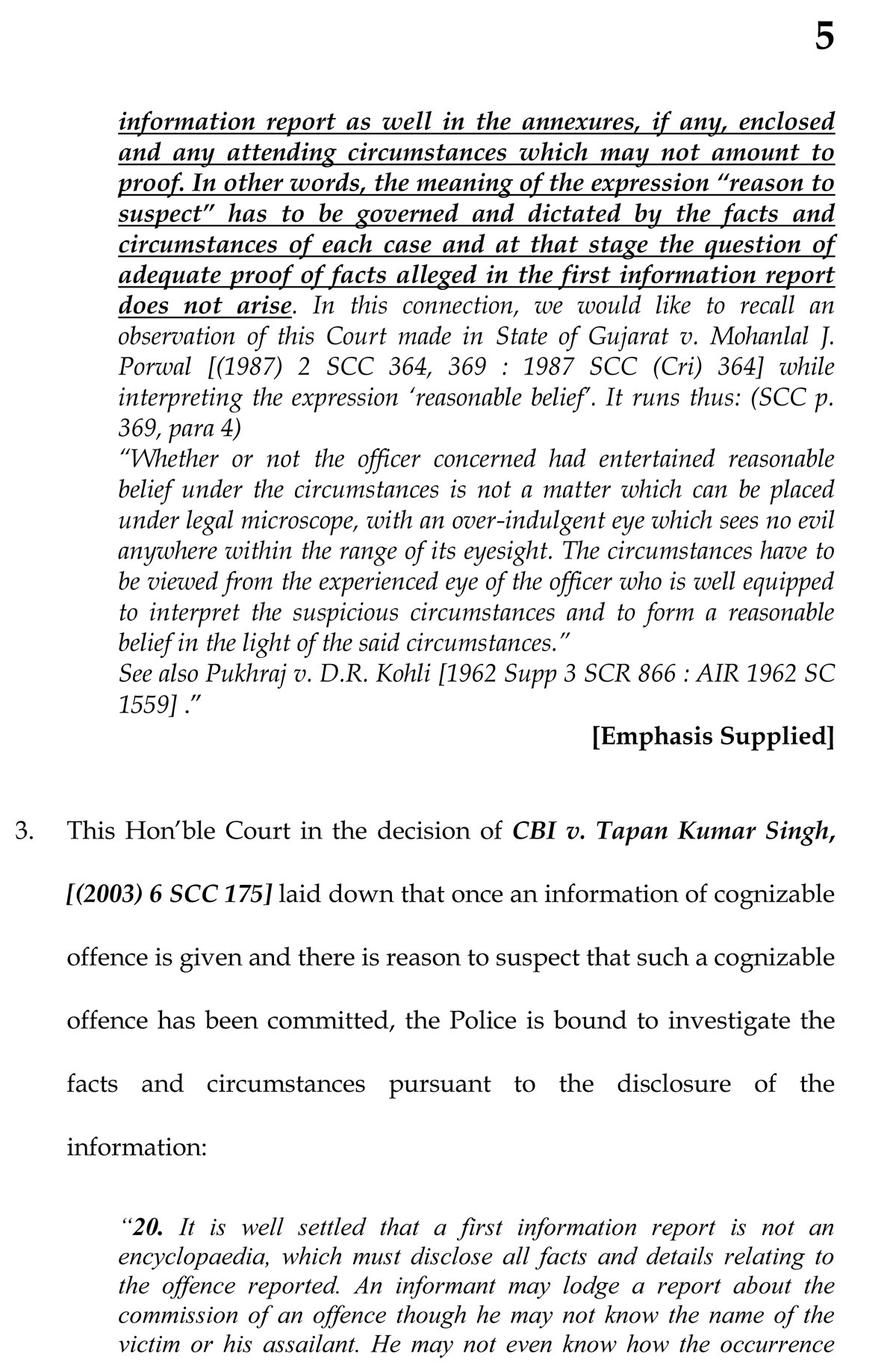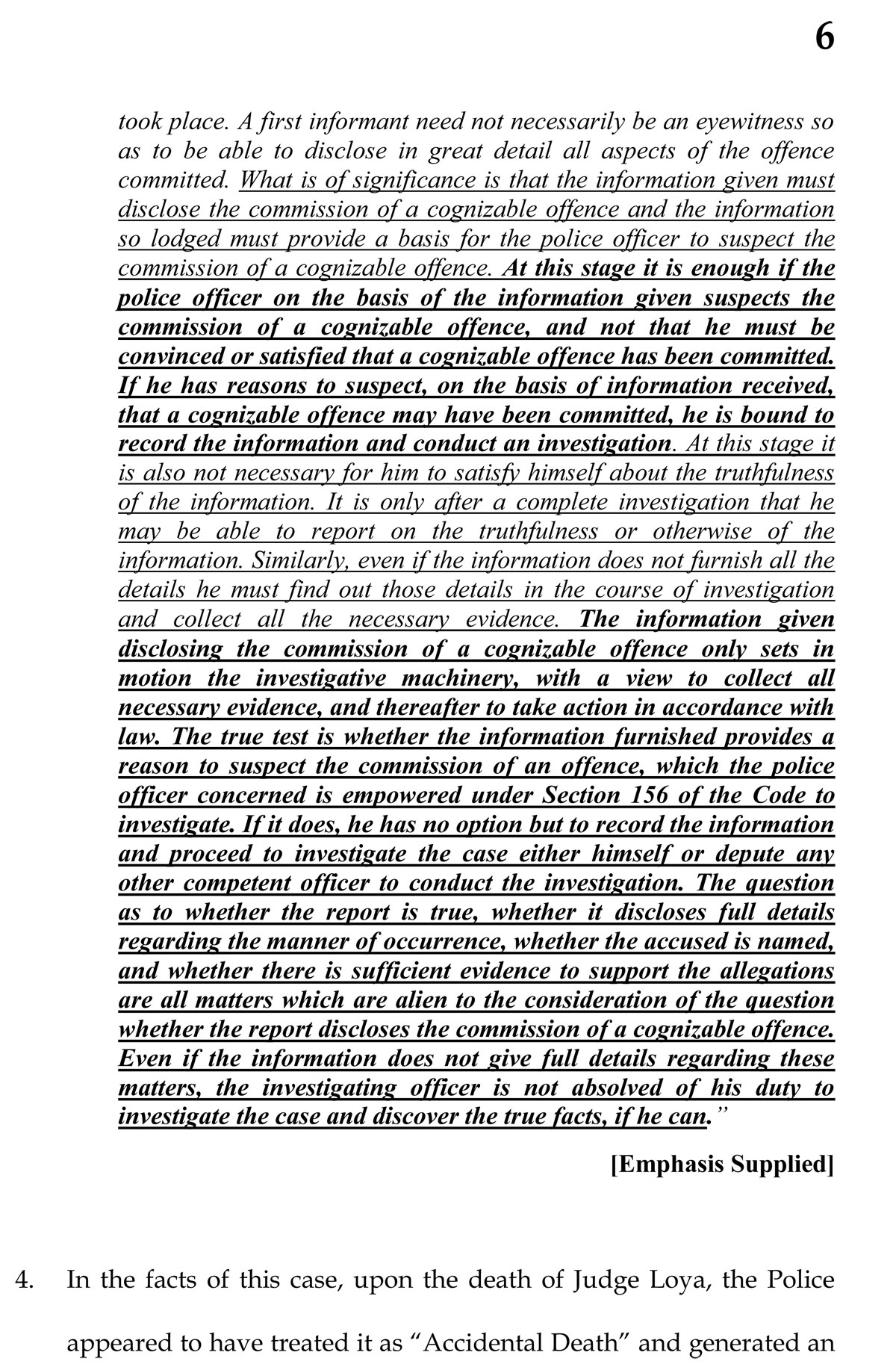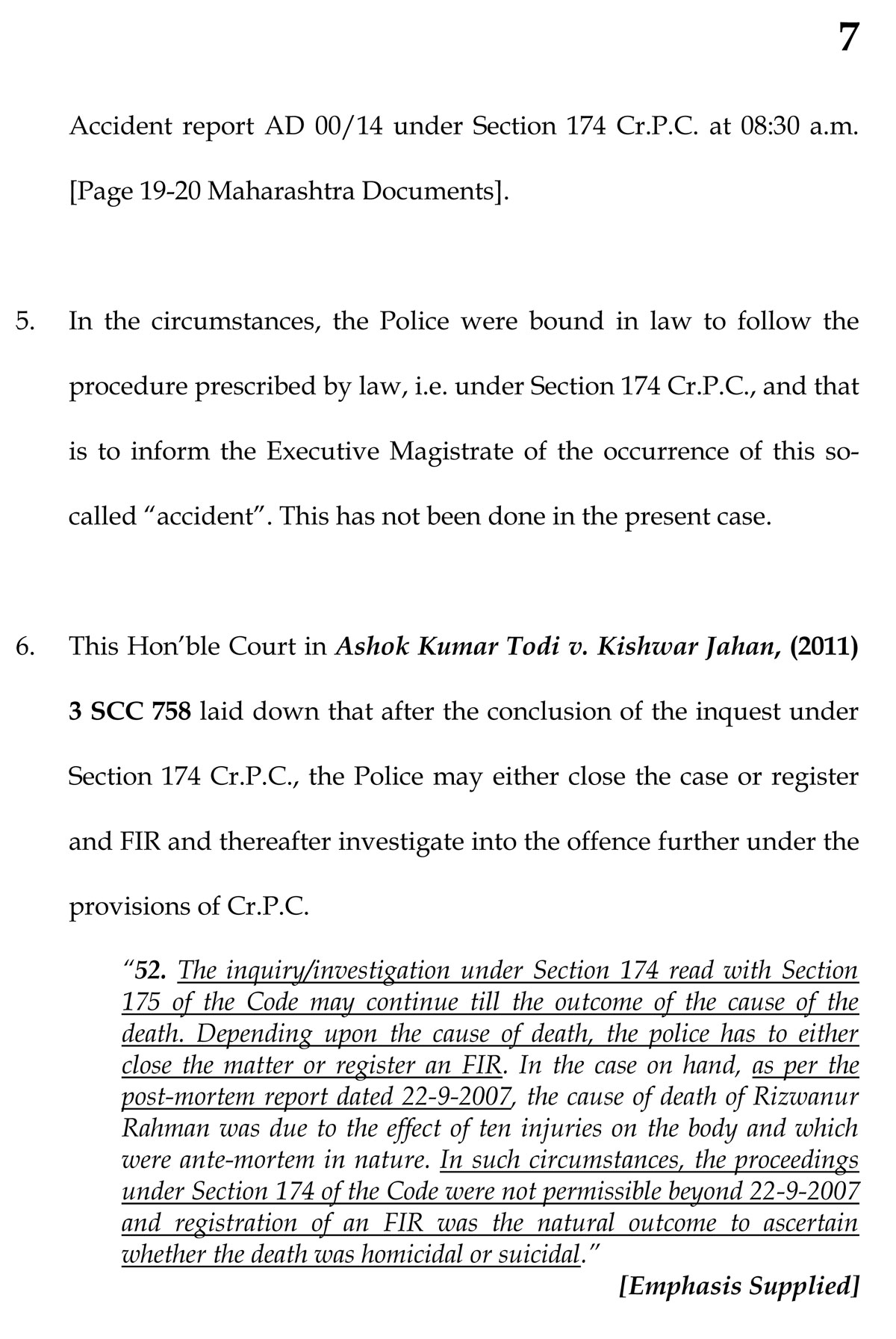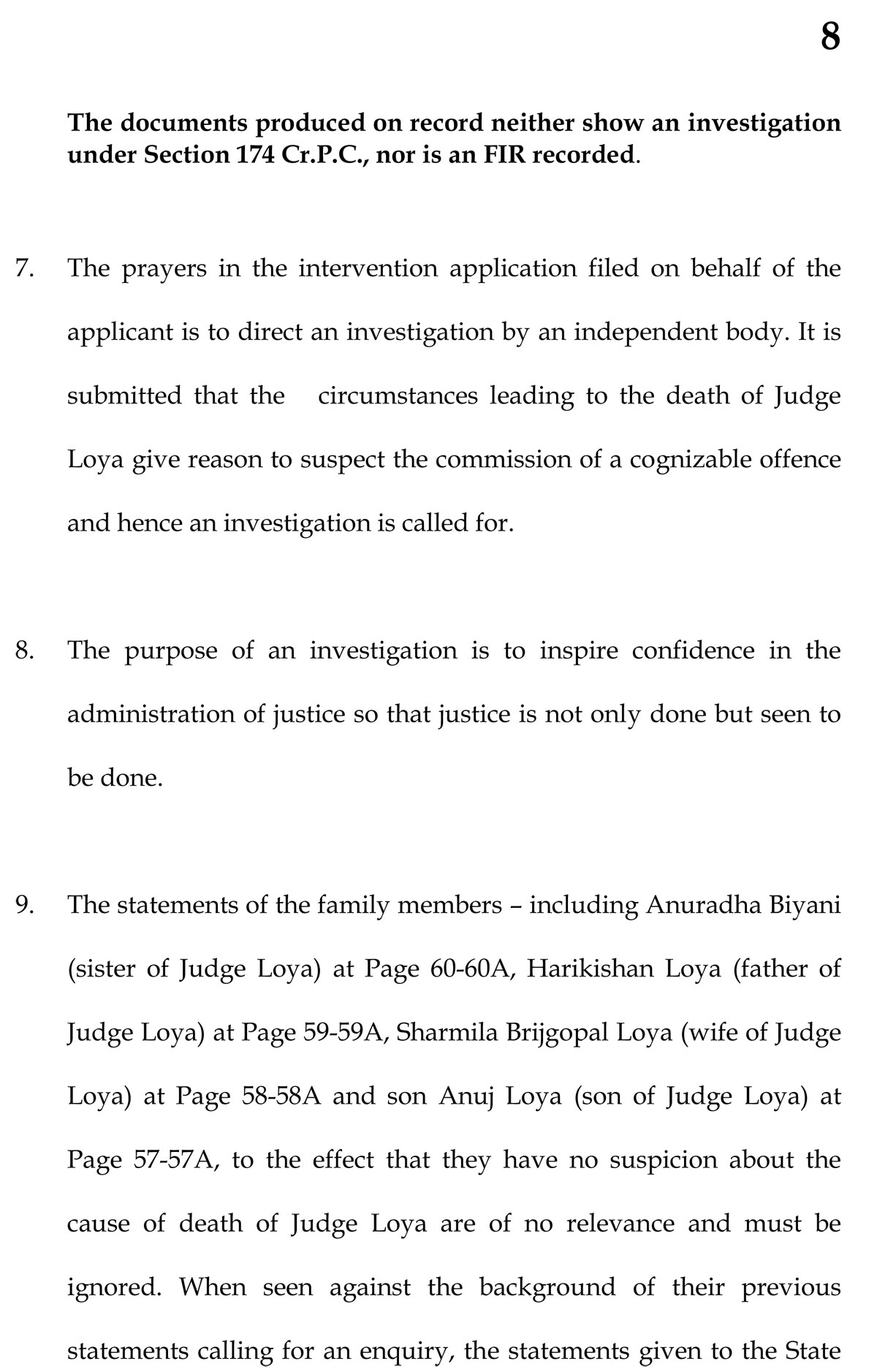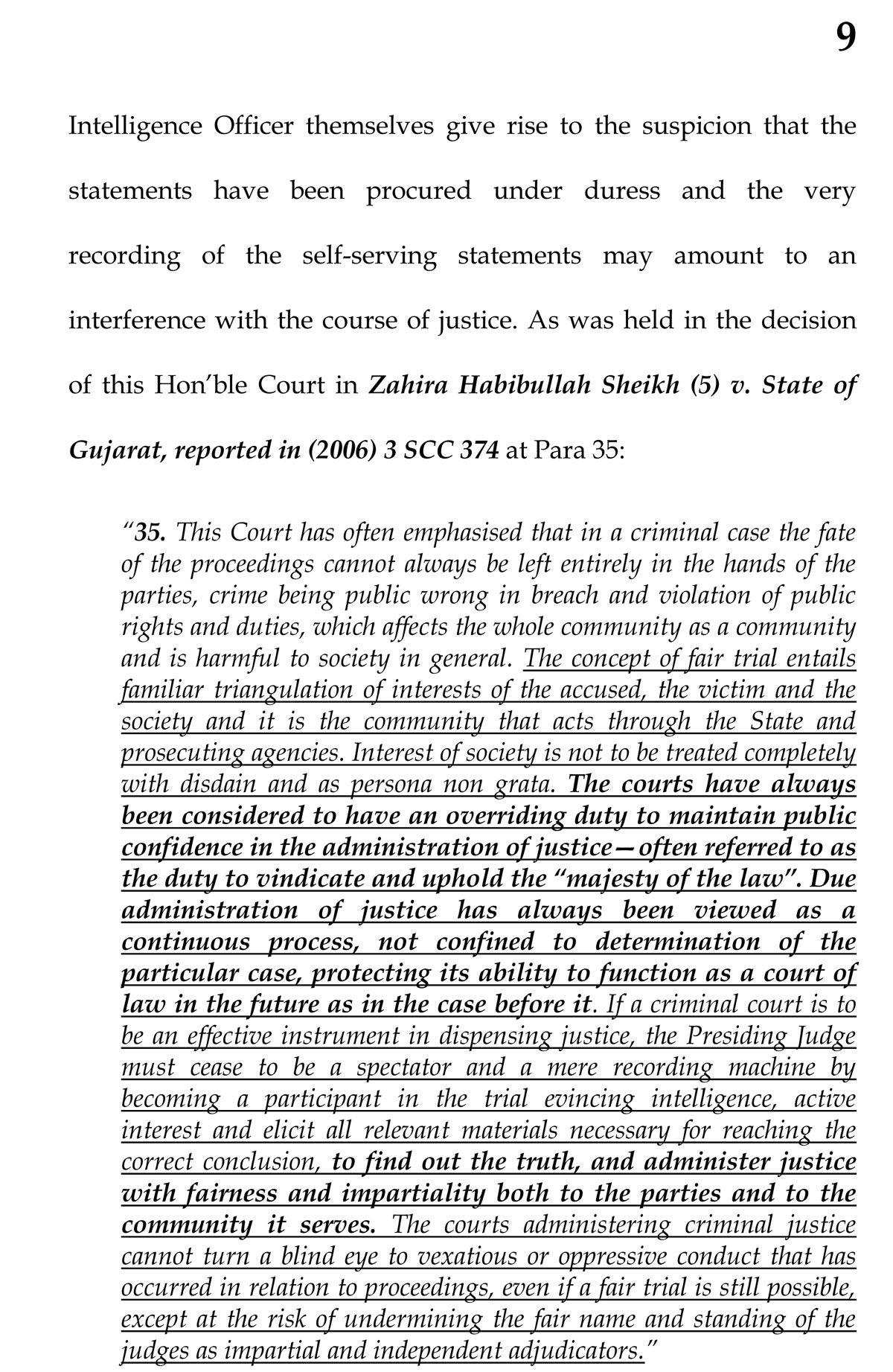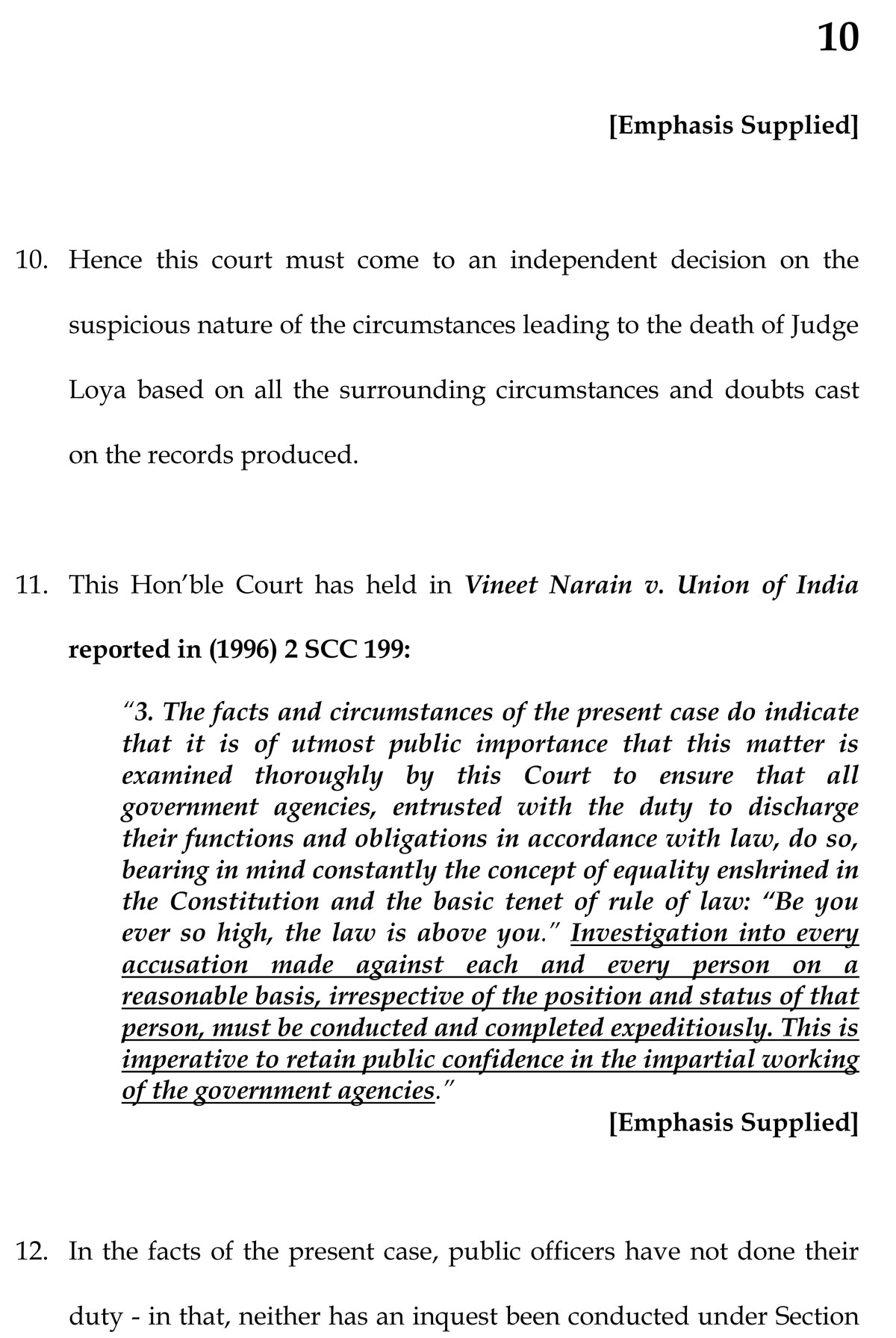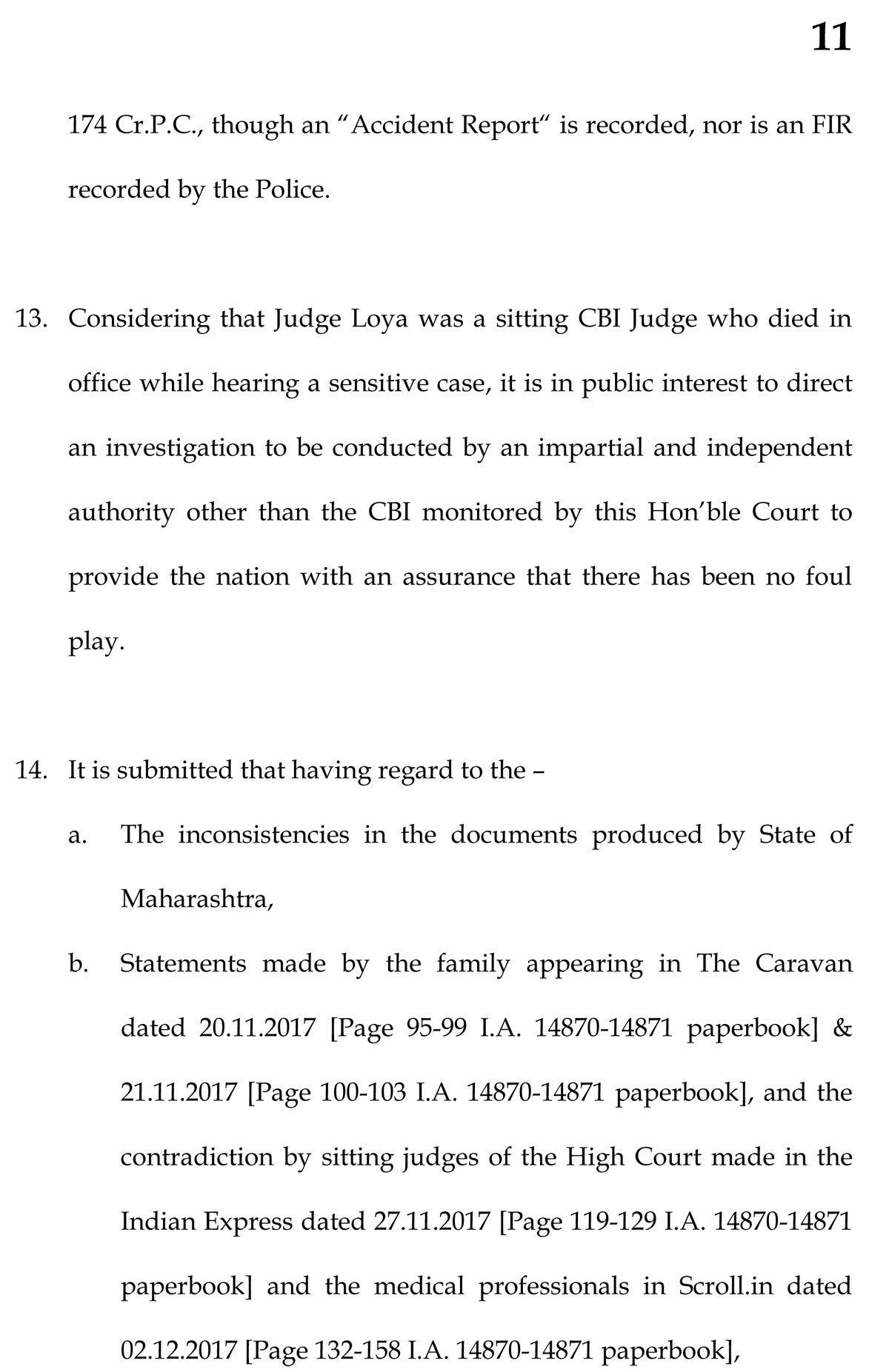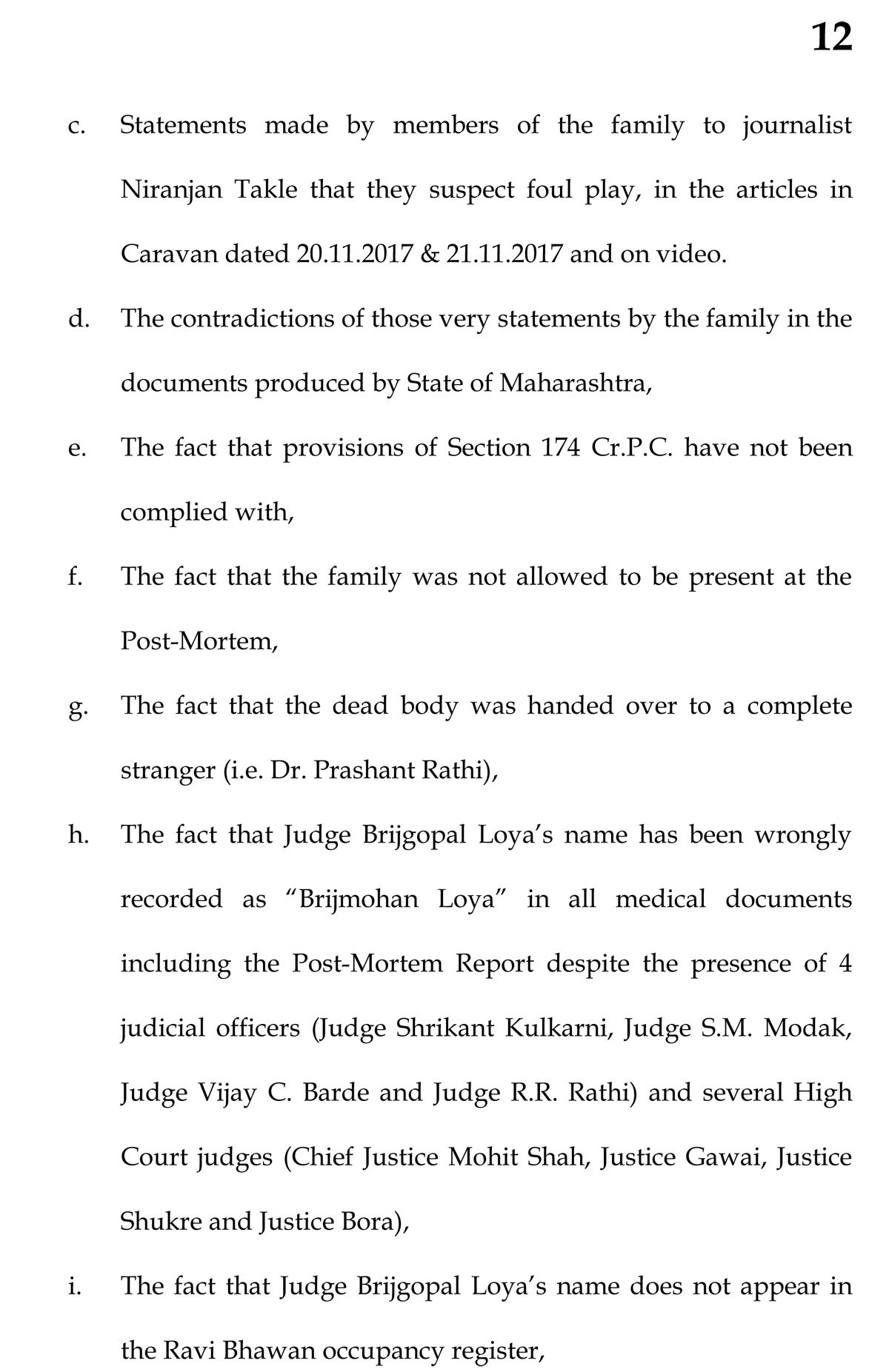Brijgopal Harkishan Loya : Judge Loya Case – Enough Reasons To Believe That A Cognizable Offence Committed: Indira Jaising
By Mehal Jain
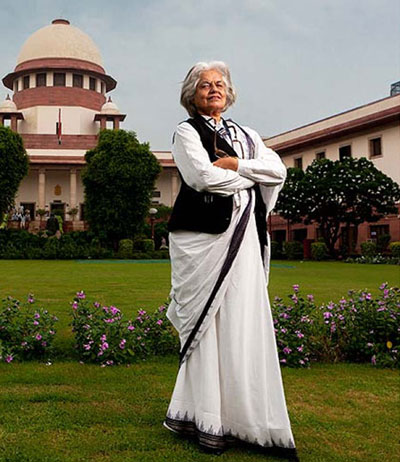 As the hearing in the two writ petitions seeking independent probe in the death of CBI Special Judge Loya resumed before the Supreme Court bench of Chief Justice Dipak Misra, Justice D. Y. Chandrachud and Justice A. M. Khanwilkar on Friday, Senior Counsel Indira Jaising advanced submissions on an intervention application.
As the hearing in the two writ petitions seeking independent probe in the death of CBI Special Judge Loya resumed before the Supreme Court bench of Chief Justice Dipak Misra, Justice D. Y. Chandrachud and Justice A. M. Khanwilkar on Friday, Senior Counsel Indira Jaising advanced submissions on an intervention application.
“There are two sets of submissions, one, on the basis of law, and the other, on the basis of facts. The former are primarily regarding the contravention of the provisions of section 174 of the Cr. P. C.,” she stated.
Emphasising on the term ‘accident’ in subsection (1) of the aforesaid section 174 and the phrase ‘any doubt regarding the cause of death’ in clause (iv) of its subsection (3), she submitted, “The police documents say ‘Accidental Death Intimation’ and also express doubt regarding the cause of the death. So why was the nearest Executive Magistrate not approached?”
Referring to the provisions of section 176 of the Cr. P. C. on the inquiry by a magistrate into a death covered under section 174, she advanced, “Section 176 permits the magistrate to even disinter a dead body for examination. Further, the explanation appended to the section defines ‘relative’ as ‘parents, children, spouse, brothers and sisters.’ So how was judge Loya’s dead body handed over to Dr. Prashant Rathi? And why was his family not present at the time of the post-mortem?”
“The ‘Accidental Death Summary’ of PS Sitabardi triggered the application of section 174. There are repeated references to section 174 in the Accidental Death Intimation recorded at PS Sadar at 4 PM on December 1, 2014. But the Intimation to the Sub Divisional Magistrate was sent only on February 2, 2016, why not on December 1, 2014? Even in that intimation, the term ‘Accidental Death Summary’ has been used and not investigation or inquiry,” she continued.
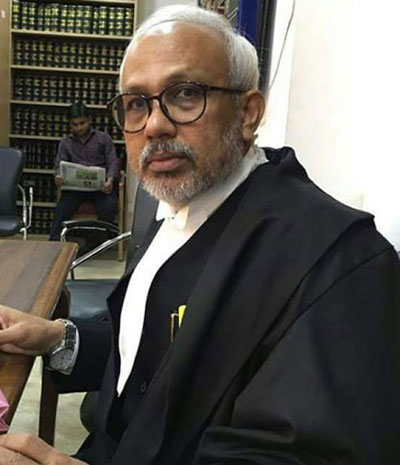 Moving on, Ms. Jaising submitted, “The Inquest Panchnama of the personal belongings has not been produced. It was said the mobile phone was returned a few days later. There is also a discrepancy with regard to clothes. Further, how is the date of death in the inquest report dated December 1, 2014 written as December 7, 2014?” “December 1, 2014 only has been mentioned as the date of death. It is only because of the way of writing that 1 is appearing as 7,” retorted Senior Counsel Mukul Rohatgi, appearing for the State of Maharashtra. “It is a suspicious circumstance that Judge Brijgopal Loya’s name has been wrongly recorded as Brijmohan Loya in all medical documents including the post-mortem report despite the presence of 4 judicial officers (Judge Shrikant Kulkarni, Judge S.M. Modak, Judge Vijay C. Barde and Judge R.R. Rathi) and several High Court judges (Chief Justice Mohit Shah, Justice Gawai, Justice Shukre and Justice Bora),” she reiterated the argument earlier advanced by Senior Counsels Dushyant Dave and V. Giri.
Moving on, Ms. Jaising submitted, “The Inquest Panchnama of the personal belongings has not been produced. It was said the mobile phone was returned a few days later. There is also a discrepancy with regard to clothes. Further, how is the date of death in the inquest report dated December 1, 2014 written as December 7, 2014?” “December 1, 2014 only has been mentioned as the date of death. It is only because of the way of writing that 1 is appearing as 7,” retorted Senior Counsel Mukul Rohatgi, appearing for the State of Maharashtra. “It is a suspicious circumstance that Judge Brijgopal Loya’s name has been wrongly recorded as Brijmohan Loya in all medical documents including the post-mortem report despite the presence of 4 judicial officers (Judge Shrikant Kulkarni, Judge S.M. Modak, Judge Vijay C. Barde and Judge R.R. Rathi) and several High Court judges (Chief Justice Mohit Shah, Justice Gawai, Justice Shukre and Justice Bora),” she reiterated the argument earlier advanced by Senior Counsels Dushyant Dave and V. Giri.
“Finally, the case diary has not been furnished. It is important to know the time at which the police station received a call that an accidental death has ensued. The diary would also provide a minute by minute account of the happenings so that Your Lordships can decide if these documents have been generated contemporaneously or later,” she continued.
Moving on to the hospital records, Ms. Jaising said, “The doctor’s progress report says ‘ECG done,’ but by whom? At Dande or at Meditrina? Why has the ECG report not been produced?”
When Justice Chandrachud referred to a statement on record to the effect that an ECG was carried out at the Dande Hospital, Ms. Jaising advanced that the statement is “most likely false” as the ECG report has not been furnished, the person making the statement is not an eye witness to the fact of the ECG and that it is contravention of the statement of Judge Rupesh Rathi, which she regarded as the “most credible statement.”
Thereupon, she quoted portions from Judge R. Rathi’s statement “…At Ravi Bhawan, Judge Loya was attending to nature’s call when he appeared complaining of chest pain…he was taken to Dande Hospital in judge Barde’s car…Judge Waikar’s help was also sought…the hospital was on the first floor so we climbed the stairs…Judge Loya was sweating…the doctor tried to carry out the ECG but the machine was broken and could not be fixed…the doctor administered two injections to judge Loya…I called my cousin Dr. Prashant Harkoot who recommended that we immediately bring Judge Loya to Meditrina Hospital…there were two separate cars…by the time we reached Meditrina, Judge Loya was unconscious and was taken inside for treatment…he was treated for some time after which we came to know he had suffered a heart attack…finally, we came to know that he had passed away…it was an extremely sad and unfortunate incident…”
“We do not know if the cause of the death was heart attack or not. To ascertain the cause of death, it is necessary that the family members narrate the clinical history which is to be matched with the hospital reports. But the requirement of section 174 of the Cr. P. C. was not followed.
“Judge Loya’s sister has stated that family history, habits of smoking, tobacco consumption and drinking, a condition of obesity etc are regarded as factors leading to a heart attack by cardiologists, but none of these were applicable to her brother. He was only 48 years old. Their parents were over 80 years old, alive and healthy. He did not even have a sedentary lifestyle and routinely indulged in sports,” she continued.
“When there is doubt regarding the cause of death, it is for the Investigating Officer to decide whether to pursue the procedure under section 174 of the Cr. P. C. or to register a FIR. In this case, neither was done. This is my submission,” advanced Ms. Jaising.
She cited the judgment on State of Haryana vs. Bhajan Lal (1990) in so far as it was observed therein, “The expression ‘reason to suspect the commission of an offence’ used in section 154(1) Cr. P.C. would mean the sagacity of rationally inferring the commission of a cognizable offence based on the specific articulate facts mentioned in the First Information Report as well in the Annexures, if any, enclosed and any attending circumstances which may not amount to proof. In other words, the meaning of the expression “reason to suspect” has to be governed and dictated by the facts and circumstances of each case…”
“Statements of Loya’s wife, sister, father and son that there is nothing suspicious as to the death have been procured under duress and are self-serving statements which should be ignored in view of their earlier statements. The sister is a credible witness as all her statements have been corroborated. R. Rathi has backed the claim regarding climbing of stairs; Justice Gawai in his interview to the Indian Express has said that a car had broken down, supporting Loya’s sister’s statement that he had reached the hospital unaccompanied,” she continued.
“In 2015, Judge Loya’s son, Anuj Loya, has made a statement that if something was to happen to him or any of his family members, then Bombay High Court Chief Justice Mohit Shah and the others involved in the conspiracy shall be responsible. And then in 2017, he has said before the Commissioner of State Intelligence that no inquiry into the death is sought?” she said towards the conclusion of her arguments.
“An investigation is needed because this has become a matter of public importance and also because the public agencies have not done their duty,” she iterated.
At this point, Mr. Rohatgi intervened, “I was just reading the submission regarding the interview in the Indian Express. It only says that the car had brushed against another car.”
“I am only creating the grounds for investigation, not proving the case beyond the reasonable doubt which would be the task of the investigator,” Ms. Jaising replied.
Referring to the 2012 Supreme Court order in CBI vs Amit Shah, transferring the Sohrabuddin trial to Maharashtra from Gujarat and directing the matter to be heard by a single judge, she submitted, “Just one day before the hearing, Judge Utpat was directed by the Administrative Committee of the High Court to report to Pune. How could the transfer have been made without an application to the Supreme Court?” “Finally, there is the letter by a retired judge of the Bombay High Court addressed to the Chief Justice of the High Court in November, 2017 for a SIT probe into the death of Judge Loya,” advanced Ms. Jaising.
“Ms. Jaising is seeking an investigation but she has not done any homework. She is talking about the transfer of Judge Utpat, the Sohrabuddin trial, the story in the Caravan & CineBuster? Why is the letter of the retired Bombay High Court judge being relied upon? It was written after the story in the Caravan & CineBuster was published. Is this a PIL?” questioned Mr. Rohatgi. “Are you trying to say I have a motive? Fine,” retorted Ms. Jaising, concluding her submissions.
“There is enough reason to suspect that a cognizable offence has been committed,” Jaising concluded Thereupon, Senior Counsel P. V. Surendranath, appearing on behalf of intervener All India Lawyers’ Union, pressed the prayer for a direction under Article 142 of the Constitution in respect of the security arrangements of judicial officers as well as guidelines for the independence of the judiciary from the executive.
Mr. Mukul Rohatgi shall make arguments on behalf of the State of Maharashtra on Monday.
Read the Written Submissions of Senior Advocate Indira Jaising Here
Loya – Written Submission
THE HON’BLE SUPREME COURT OF INDIA
CIVIL ORIGINAL JURISDICTION
I.A. NO. OF 2018
IN
WRIT PETITION (C) NO. 20/2018
IN THE MATTER OF:
BANDHURAJ SAMBHAJI LONE … PETITIONER PETITIONER VersusUNION OF INDIA & ANR. … RESPONDENTS
AND
IN THE MATTER OF:
ALL INDIA LAWYERS UNION,REPRESENTED BY ITS SECRETARY GENERAL SOMDUTTA SHARMA FLAT No. 29, SHANKER MARKET, CANNAUGHT PLACE, NEW DELHI-110001.… APPLICANT/INTERVENERWRITTEN SUBMISSION BY P.V. SURENDRANATH, SR. COUNSEL
1. All India Lawyers Union is the largest lawyers’ organisation formed pro bono publico with objectives, inter alia, of protection of rule of law, human rights& independence of judiciary. It is very much concerned about threat to independence of judiciary from within & without.
2. The issue before this Hon’ble Court is concerning discharging judicial functions of administration of justice by a member of Subordinate Judiciary, without fear or favour and without external influence or interference from any quarter and whether there is any violation of the asme. It is an issue of threat to independence of judiciary.
3. This Hon’ble Court while hearing the matter rightly pointed out that the scope of this hearing is only confined to the death of the Judicial Officer Shri Brijgopal Harikrishan Loya on 01/12/2014 and not extended to Sohrabuddin fake encounter case trial, before him or its trajectory; the transfer of the predecessor officer etc. Hence I may not touch upon anything regarding the trial in Sohrabuddin case and the points surrounding it referred to above, except mentioning the circumstances under which and the reasons for transferring the case from Gujrat to a Special Bench in Mumbai, Maharashtra with particular reference to observations and finding of this Hon’ble Court in various judgments on the subject.
4. We may not take the luxury of wasting this court’s precious judicial time by repeating what the other senior members of the Bar, Mr. Dave, Mr. Giri and Ms. Indira Jaising have effectively submitted demonstrating the stark inconsistencies, contradictions, improbabilities and glaring & severe omissions in the statement of persons recorded by the office of the Commissioner of State Intelligence Department, State of Maharashtra. As each individual is a unique person, definitely the conduct & behaviour also may be unique & varied and cannot be termed as abnormal. Abnormal becomes normal! Still the concept of prudent man and prudent conduct & behaviour is germane to criminal jurisprudence and evidence act.
5. Individual inconsistencies or contradictions taken in isolation may not create any suspicion or doubt , but the cumulative effect of such inconsistencies and contradictions in the statements recorded in the given case by the state intelligence and produced before this Hon’ble Court if viewed and analysed in the following background of facts :i. That the nature of the crime in Sohrabuddin case,ii. The status , position ,power & influence of the accused, iii. The circumstances under which and the reasons for transferring the case from Gujarat to a special court in Mumbai, Maharashtra,iv. The subsequent development of discharge of certain accused, immediately after the new presiding officer took charge after the sad demise of Judge Loya.v. There was no security to Judge Loya at the relevant point of time, despite the nature of the criminal case – the trial of which he was conducting & the power & influence of the accused therein. (The allegation/ controversy is that security earlier provided to him was withdrawn one week before the eventful night. The Annexure: A/4 produced by Bombay Lawyers Association along with the written submission also may be referred to); Show that the circumstances surrounding the death of Judge Loya-shrouded in mystery- is a serious matter of suspicion and doubt, to be investigated/ enquired into by an independent body.
6. In view of the above aspect, the observations , findings & apprehensions of this Hon’ble Court in the decision reported as Vineet Narain & Ors v Union Of India & Anr. ( 1998) 1 SCC 226 ( para50), & the judgment in the case reported as Central Bureau of Investigation v Amitbhai Anil Chandra Shah & Anr. ( 2012) 10 SCC 545(paras 1 to 13 , 28, 31, 38, 39 & 41) are very pertinent & relevant to be referred to at this juncture. The apprehension expressed by this Hon’ble Court is aggravated due to the subsequent development. The powerful & influential accused has become more powerful & more influential now. The judgment in the case reported as Vineet Narain & Ors v Union Of India & Anr. ( 1998) 1 SCC 226 is annexed herewith and marked as Annexure: W/S-1. The judgment in the case reported as Central Bureau of Investigation v Amitbhai Anil Chandra Shah & Anr. ( 2012) 10 SCC 545 is annexed herewith and marked as Annexure: W/S-2.
7. The starking inconsistencies, contradictions and omissions in the report submitted by the State Intelligence Department can be viewed, analysed and appreciated in this background only. It is shrouded in mystery and it does not inspire any confidence at all. The enquiry is farcical & perfunctory.
8. In the above circumstances this Hon’ble Court may order an independent enquiry by a Special Investigation Team of independent persons under the supervision of this Hon’ble Court under the principle of “continuing Mandamus”.
9. Moreover, this is a fit case to issue certain directions under Article 142 of the Constitution of India on the security of the judges as well as on Judges accepting engagement& positions in /under the Government / public offices/in the legislature,executive & quasi- judicial bodies & also on the abuse of Public Interest Litigation for personal & political gain & to frustrate just judicial process.
10. If the Judges assigned to hear the cases in which wide and deep human right issues are involved with the ‘State’ and powerful/influential people on the other side are not provided with adequate security in as much as to fail all extraneous pressures- physical & mental, present &future- the rule of law will be the real victim with lasting impact on the direction future jurisprudence will take. Hence the judges hearing sensational cases involving political & executive heavy weights and/or powerful and influential people may be provided immediate additional “z category” security if the judge/s assigned with the case makes a request.
11. Guidelines may be made by this Hon’ble Court to provide a reasonable “cooling off period” for the judges accepting any public office in legislature, executive or quasi-judicial bodies/ tribunals or any other office in their post-retirement period, as the people in this country shall have no occasion to think that the retired judge has received a consideration for the way in which a case involving certain influential persons/ the Government was decided in a certain manner. This is important to augment the belief upon the independence of judiciary and rule of law as in the past, at least in a few occasions, the general public had occasion to link the retired judges getting appointed to certain offices with the sensational cases they have decided in their active career as serving judges.
12. This Hon’ble Court may also take stringent action against abuse of the process of the PIL for frustrating the just judicial process & genuine Public Interest Litigations by pre-emptive measures with personal or political motives. The Written Brief submitted in WP ( C ) 20/2018, to which the applicant herein sought impleadment, reveals that the intention of the petitioner is not to facilitate free flow of justice and judicial process, but to frustrate the same by way of pre-emptive action.
FILED BY: RESMITHA R. CHANDRAN, ADVOCATE-ON-RECORD
Death of Judge Loya: Medical documents rule out heart attack, says leading forensic expert in a conversation with ATUL DEV.
 After examining medical documents pertaining to the death of Judge Brijgopal Harkishan Loya, one of India’s foremost forensic experts, Dr RK Sharma – former head of the Forensic Medicine and Toxicology Department at the All India Institute of Medical Sciences in Delhi, and the president of the Indian Association of Medico-Legal Experts for 22 years – has dismissed the official claim that Loya died of a heart attack. According to Sharma, the documents show signs of possible trauma to the brain, and even possible poisoning.
After examining medical documents pertaining to the death of Judge Brijgopal Harkishan Loya, one of India’s foremost forensic experts, Dr RK Sharma – former head of the Forensic Medicine and Toxicology Department at the All India Institute of Medical Sciences in Delhi, and the president of the Indian Association of Medico-Legal Experts for 22 years – has dismissed the official claim that Loya died of a heart attack. According to Sharma, the documents show signs of possible trauma to the brain, and even possible poisoning.
Sharma spoke about this after studying Loya’s post-mortem and histopathology report, a report that accompanied  samples of Loya’s viscera that were sent for chemical analysis, and the results of the chemical analysis. Some of these documents have been procured through Right to Information applications, and others have been submitted to the Supreme Court by the Government of Maharashtra in support of a report by Maharashtra’s State Intelligence Department that concludes there is no cause for suspicion regarding Loya’s death. Sharma’s expert opinion contradicts this conclusion.
samples of Loya’s viscera that were sent for chemical analysis, and the results of the chemical analysis. Some of these documents have been procured through Right to Information applications, and others have been submitted to the Supreme Court by the Government of Maharashtra in support of a report by Maharashtra’s State Intelligence Department that concludes there is no cause for suspicion regarding Loya’s death. Sharma’s expert opinion contradicts this conclusion.
“There is no evidence of myocardial infarction in the histopathology report,” Sharma said. “The findings in this report have no suggestion of a heart-attack. They show changes, but not a heart attack.”
Sharma observed, “The post-mortem report also says that calcification is observed in the vessels. Where there is calcification, there is no heart attack. Once the vessels have calcified they will never block the flow of blood.”
 Loya is reported to have complained of feeling unwell at about 4 am on the night of his death, and was declared dead at 6.15 am. “So that means two hours,” Sharma said. “If one is alive for more than 30 minutes after the symptoms [of a heart attack] show, the condition of the heart will have clear changes. No clear changes can be seen here.”
Loya is reported to have complained of feeling unwell at about 4 am on the night of his death, and was declared dead at 6.15 am. “So that means two hours,” Sharma said. “If one is alive for more than 30 minutes after the symptoms [of a heart attack] show, the condition of the heart will have clear changes. No clear changes can be seen here.”
The post-mortem report states that the probable cause of death was “coronary artery insufficiency” to which Sharma said, “there are changes observed in heart in these documents, but none of them are conclusive enough to show ‘Coronary Artery Insufficiency.’ Every patient who goes for a bypass surgery will have these symptoms.”
 “More importantly, dura is congested according to the post-mortem report,” Sharma added. “Dura mater is the outermost layer that surrounds our brain. It is damaged in cases of trauma, which indicates some kind of an assault on the brain. A physical assault.”
“More importantly, dura is congested according to the post-mortem report,” Sharma added. “Dura mater is the outermost layer that surrounds our brain. It is damaged in cases of trauma, which indicates some kind of an assault on the brain. A physical assault.”
Dr Anuradha Biyani, Loya’s sister and a medical doctor in the service of the Maharashtra government, told Atul Dev earlier that, when she saw her brother’s body for the first time after his death, “there were bloodstains on the neck at the back of the shirt.” Biyani maintains a diary, and in an entry from the time of Loya’s death she recorded that “there was blood on his collar.” Sarita Mandhane, Loya’s other sister, had also mentioned “blood on the neck” when she spoke to me, and that “these was blood and an injury on his head … on the back side.” Harkishan Loya, the judge’s father, told me that he remembered “bloodstains on the clothes.”
 Among the state of Maharashtra’s submission to the Supreme Court is a bill in Loya’s name from Nagpur’s Meditrina Hospital, where the judge was declared dead. While Meditrina officials maintain that Loya was brought in with heart problems, this document inexplicably lists “neurosurgery” as a billed item.
Among the state of Maharashtra’s submission to the Supreme Court is a bill in Loya’s name from Nagpur’s Meditrina Hospital, where the judge was declared dead. While Meditrina officials maintain that Loya was brought in with heart problems, this document inexplicably lists “neurosurgery” as a billed item.
The post-mortem report does not record precisely how much congestion of dura was observed. Sharma said he found it strange that “the reason why dura is congested is not written.”
“There is a possibility of poisoning,” Sharma continued, looking at the post-mortem report. “Every single organ is congested.” The organs recorded as “congested” in the report include the liver, pancreas, spleen, kidneys, oesophagus and lungs, among others.
 The findings of the chemical analysis on Loya’s viscera samples, submitted 50 days after the judge’s death, did not identify any poison. The analysis was performed at the Regional Forensic Science Laboratory in Nagpur. It is recorded as having started on 5 January 2015 – 36 days after Loya’s death, on the night intervening between 30 November and 1 December 2014- and finished 14 days later, on 19 January 2015. “Why did it take so long for the analysis,” Sharma asked, “it generally takes a day or two [to complete the analysis].”
The findings of the chemical analysis on Loya’s viscera samples, submitted 50 days after the judge’s death, did not identify any poison. The analysis was performed at the Regional Forensic Science Laboratory in Nagpur. It is recorded as having started on 5 January 2015 – 36 days after Loya’s death, on the night intervening between 30 November and 1 December 2014- and finished 14 days later, on 19 January 2015. “Why did it take so long for the analysis,” Sharma asked, “it generally takes a day or two [to complete the analysis].”
The chain of custody of Loya’s viscera sample appears to have been broken in the aftermath of the post-mortem. According to documents submitted to the Supreme Court by the state of Maharashtra, a zero-FIR regarding Loya’s death was first registered at Nagpur’s Sitabuldi police station. The Sitabuldi station arranged for the  post-mortem, conducted at the Government Medical College in Nagpur from 10.55 am to 11.50 am on 1 December. The samples for chemical analysis are collected at the same time. For reasons that have not yet been made clear, the FIR was then transferred to Nagpur’s Sadar police station, where records show that it was registered at 4pm. It was the Sadar station that dispatched Loya’s tissue samples for analysis with the necessary letter. It is not clear where, and with whom, Loya’s tissue samples were in the hours between the post-mortem and the registration of the FIR at the Sadar station, or under whose supervision they were handed over to the Sadar station. Nor has it been made clear why the Sitabuldi station did not send the samples to the forensic laboratory right after the post-mortem was done.
post-mortem, conducted at the Government Medical College in Nagpur from 10.55 am to 11.50 am on 1 December. The samples for chemical analysis are collected at the same time. For reasons that have not yet been made clear, the FIR was then transferred to Nagpur’s Sadar police station, where records show that it was registered at 4pm. It was the Sadar station that dispatched Loya’s tissue samples for analysis with the necessary letter. It is not clear where, and with whom, Loya’s tissue samples were in the hours between the post-mortem and the registration of the FIR at the Sadar station, or under whose supervision they were handed over to the Sadar station. Nor has it been made clear why the Sitabuldi station did not send the samples to the forensic laboratory right after the post-mortem was done.
In addition, there is no consensus on the condition of Loya’s body and the probable cause of Loya’s death as recorded in the post-mortem report and the report that accompanied Loya’s viscera samples when these were sent for analysis—despite the fact that the latter is meant to be based entirely on the former. In a field titled “rigor mortis,” meant to record how stiff a body is at the time of inspection, the post-mortem report states, “slightly present in upper limbs [and] not appeared in lower limbs.” The viscera report, under the same field, says that rigor mortis is “well marked.” Rigor mortis could not have been “slightly present” and “well marked” at the same time. In a field titled “opinion as to the probable cause of death,” the post-mortem report states, “Coronary artery insufficiency.” Under the same field, the viscera report and notes, “A case of sudden death.” In a field titled “Story of case,” the viscera report states, “A case of natural death,” with the words “natural death” underlined—and yet a report of accidental death had earlier been registered at the Sitabuldi police station before it sent Loya’s body for a post-mortem.
Both the post-mortem report and the viscera report were prepared at the Government Medical College in Nagpur. The form used for the viscera report, obtained via a Right to Information application, clearly states that the information in it must be based on the post-mortem, and must be prepared immediately after the post-mortem by the same doctor who conducted the procedure. The form in Loya’s case, filled in by the forensic department of the Government Medical College, is titled “Form in which Report of Post-mortem Examination to be used when forwarding Viscera to the Chemical Analyser.” A doctor who works in the forensic department at AIIMS in Delhi confirmed that the standard procedure is to “copy the information in the post-mortem to the form” that accompanies viscera sent to a chemical analyser. Sharma said the same thing.
In Loya’s case, both the post-mortem and the viscera reports are signed by Dr NK Tumaram, a lecturer at the Government Medical College – and yet the same doctor, in reports meant to be prepared almost simultaneously, has furnished clearly contradictory information, even on something as important as the probable cause of death. When contacted Tumaram, he said he could not speak about the case since it is being heard in court.
Loya was 48 years old at the time of his death, did not smoke or drink, and had no personal or familial history of heart ailments. “Our parents are 85 and 80 years old, and are healthy with no cardiac history,” Anuradha Biyanisaid. Loya, she added, “was always a teetotaller, played table tennis for two hours a day for years, had no diabetes or blood pressure.”
Dr RK Sharma has written five books on forensic and medico-legal issues, and has lectured and trained judges and public prosecutors on multiple occasions. He has been a consultant for the Central Bureau of Investigation, been invited to international seminars by investigative agencies such as the Federal Bureau of Investigation of the United States, and has organised numerous national and international seminars in forensic medicine and toxicology.
“Isme investigation hona chahiye” (There should be an investigation in this), Sharma said while reading the documents. He later reiterated, “The situation presented in these documents necessitates an investigation.”
Sheet of post-mortem report (left) and sheet of viscera report (right) showing contradictory opinions on probable cause of death.
Sheets of post-mortem report showing congestion of multiple organs, including the liver, pancreas, spleen, kidneys, oesophagus and lungs, among others.
Report of chemical analysis on tissue samples (left) showing date of start and end of analysis. Sheet of post-mortem report (centre) and sheet of viscera report (right) showing observations on rigor mortis.


